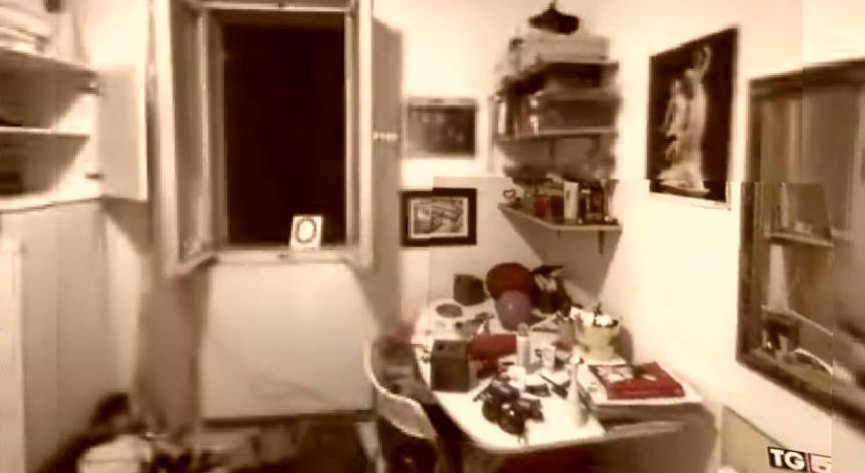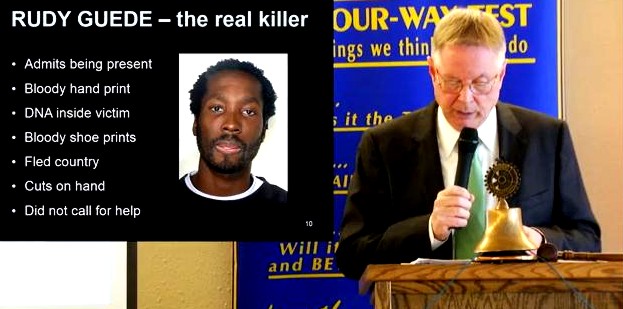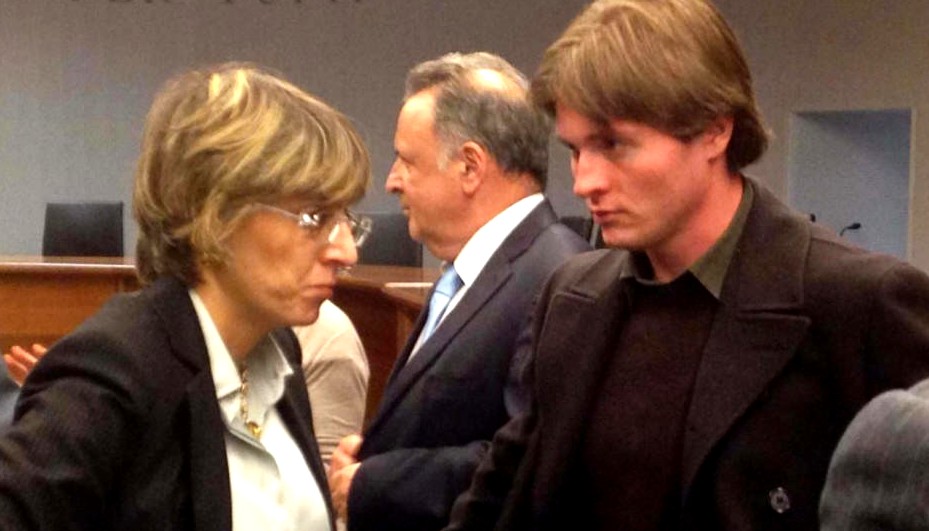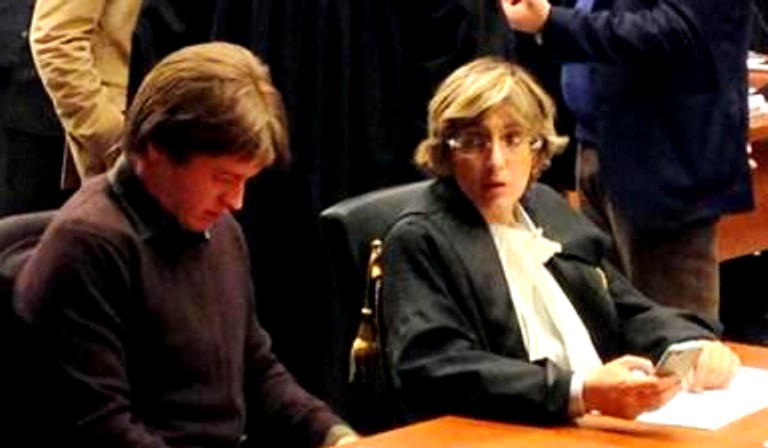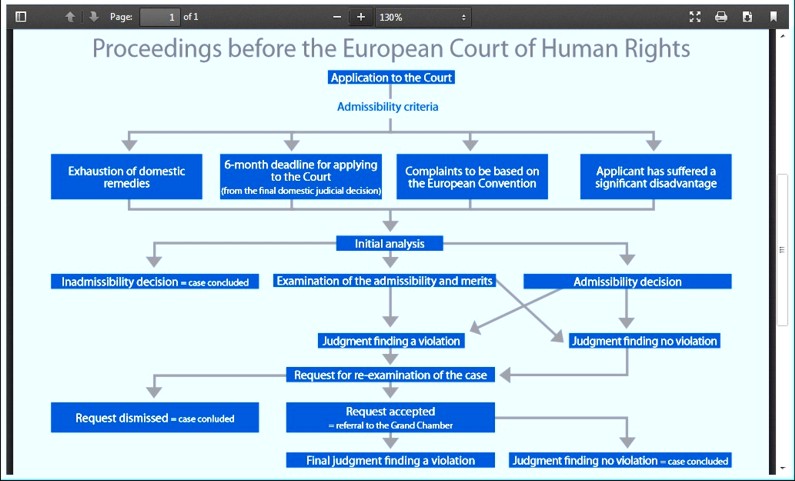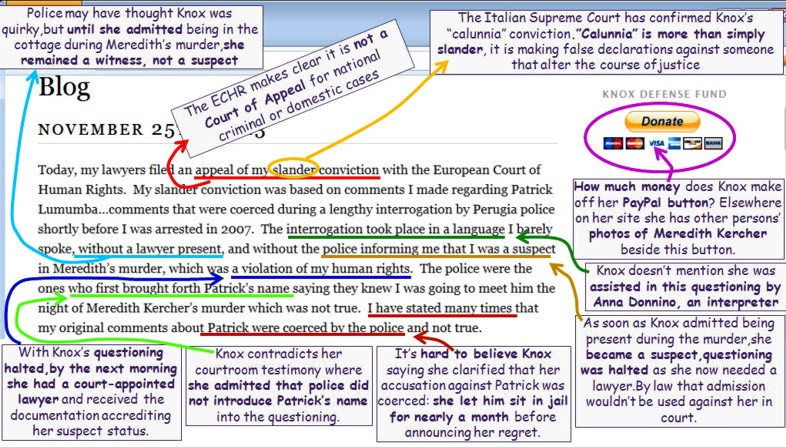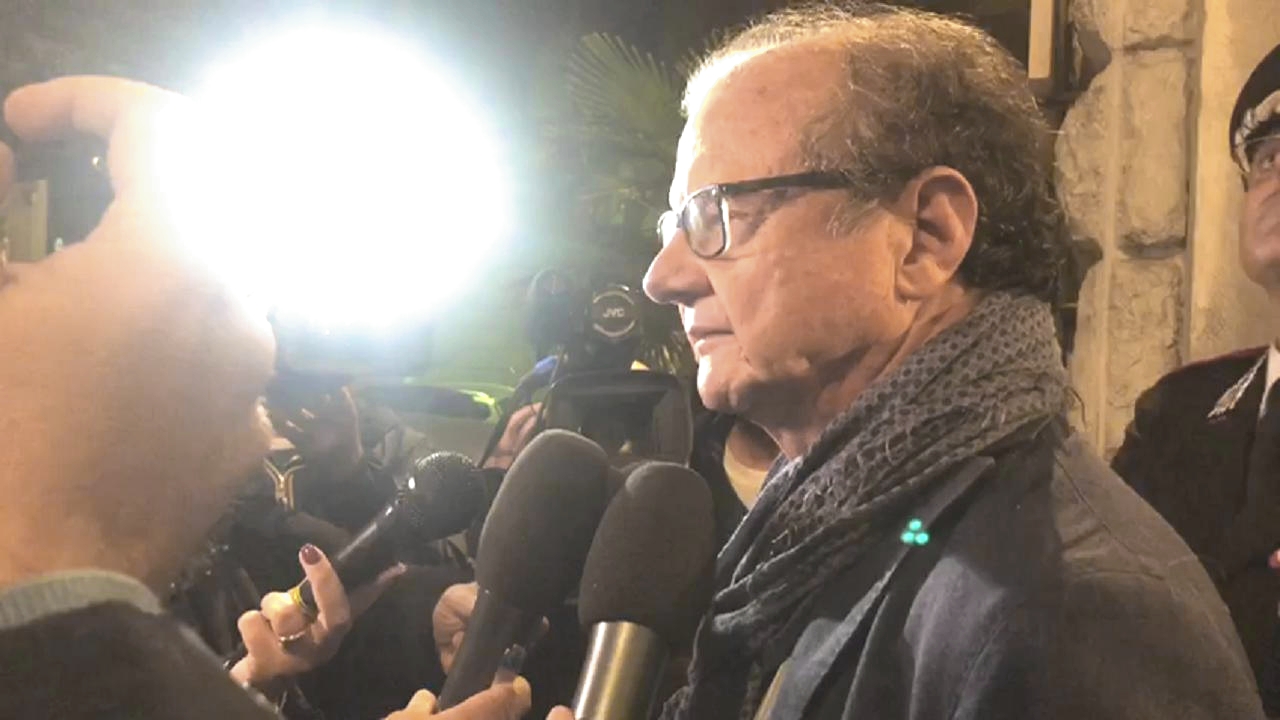
Saturday, December 14, 2013
Why Is Appeal Prosecutor Crini So Very, Very Interested In The Precise Position Of Filomena’s Door?
Posted by Cardiol MD
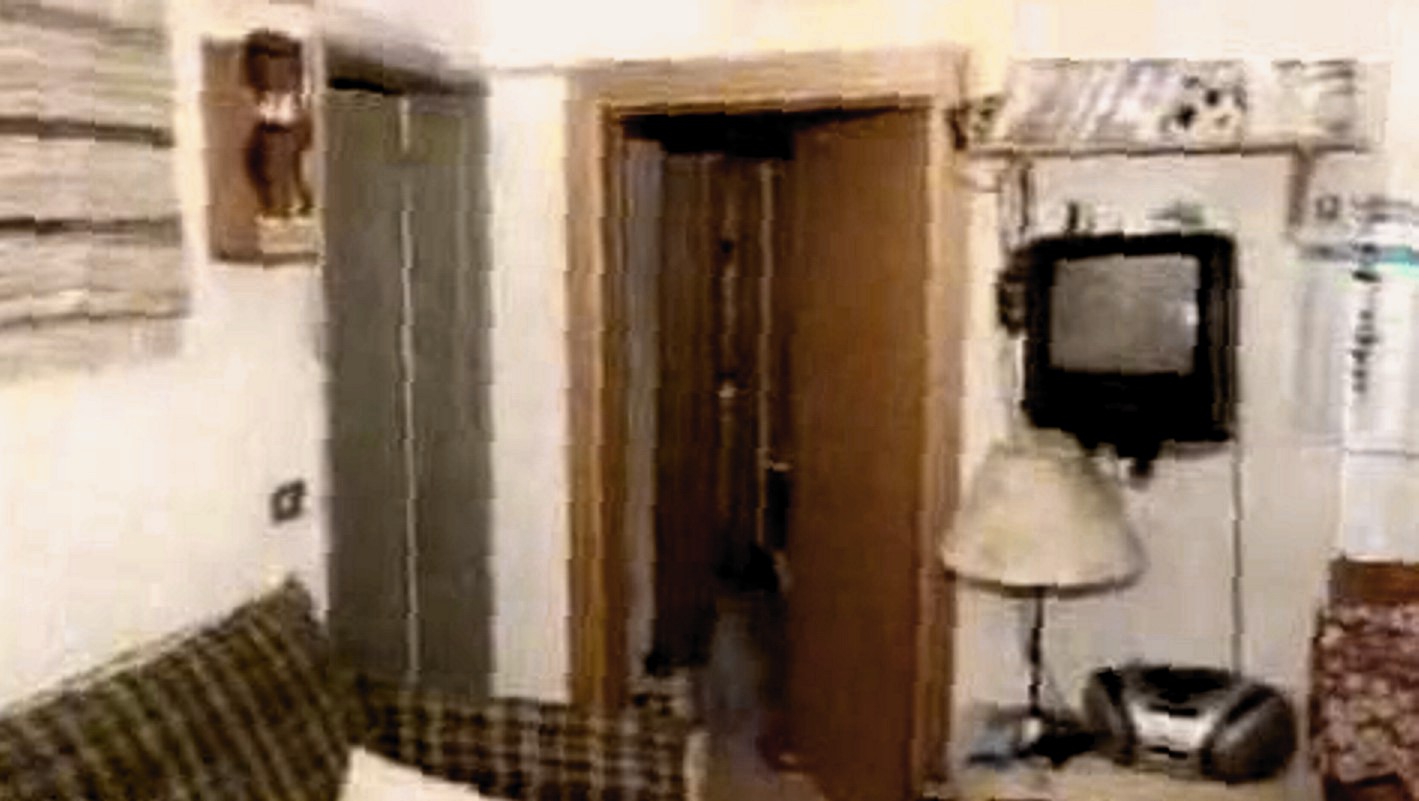
[Above, we can see Filomena’s grey door, at hard left; ahead are Meredith’s & Knox’s bedrooms]
Do please bear in mind that this appeal was initiated by Knox and Sollecito, and the verdict, sentence and sentencing report they dispute is Judge’s Massei’s from the 2009 trial.
The subject of one of Dr Crini’s focuses - whether or not Filomena’s door was open at the various times Knox and Sollecito stated they went to the women’s apartment on the morning-after ““ is a crucial one, relevant to proving Knox’s and Sollecito’s lies and obfuscations.
Wasn’t the staged break-in to Filomena Romanelli’s room glaringly obvious? In the early morning of November 2nd, 2007? In spite of the Knox/Sollecito obfuscations? There is much information in Massei on this question, pointing to many very obvious obfuscations.
Now, for the legal requirements of beyond-reasonable-doubt (BRD) actual, literal quotations are needed. Much relevant information can easily get “˜lost in translation’ not only at the superficial level of paraphrase, as in “They said that”¦..”, but also at the more subtle level of the formats used for quotations.
Some of the Massei Report as translated consists of the actual oral quotations of witness statements, some are quotations of the content of written documents, but some consist only of paraphrases of both oral statements and of written documents.
For some quotations, especially nested-quotations the translation uses various formats, beginning either with a comma or an apostrophe, ending with an apostrophe, and, in my copy, some back-slashes.
This mixture can be confusing to some readers, and Knox and Sollecito are seasoned veterans of exploiting such translational losses. That is a major factor in their continuing obstruction of justice: using chronic obfuscation.
He said, “She yelled, ‘I’m going to kill you.’ “
This quotation-format has been substituted in this post where it seems appropriate. It is hoped that when this format is used only to indicate editorial irony it will be self-evident.
John Follain and Will Savive also make a number of relevant references, and so do some Wiki articles whose authors are too modest to identify themselves though “˜Underhill’ has been mentioned as a co-ordinator.
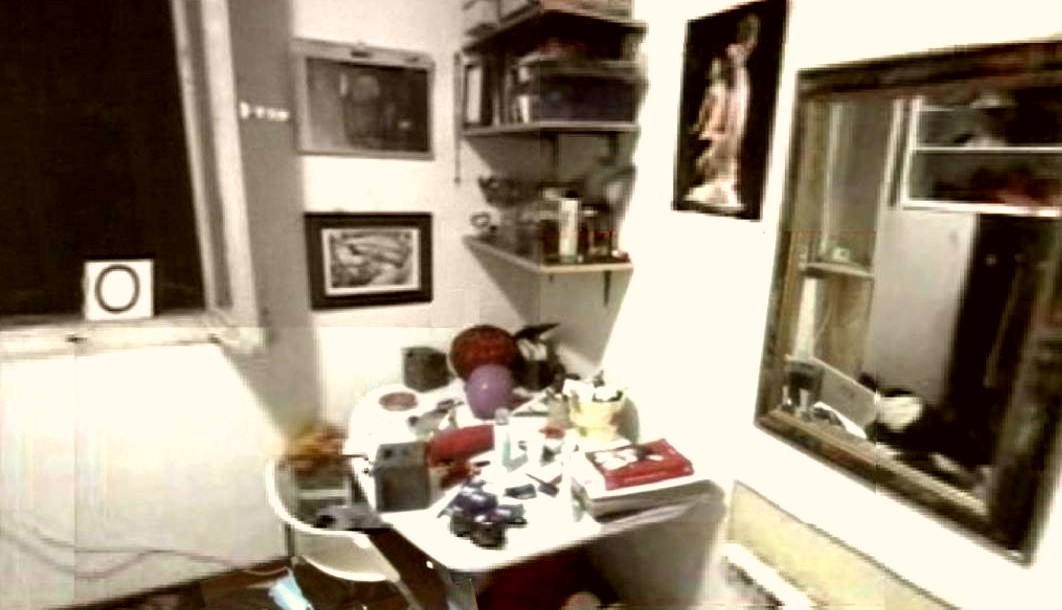
Of course, the members of the Florence Appellate Court have access-to, have probably already read, thousands of pages of evidence, including the actual verbatim witness-transcripts, and that Court will make up its own mind independent of what is written elsewhere.
Here are some of the Massei “˜door’ instances - this is a selection of a relevant 6 out of a grand total of 192 instances:
Massei Page 28: [Amanda Knox and Raffaele Sollecito ““ said that they were waiting for the carabinieri whom they had called since “coming back to the cottage in the morning because they had been away for the night” and finding “the entrance [15] door open and then the window broken” (see declarations by Battistelli, hearing of February 7, 2009, page 64).]
Access to the Court Records would help us better-understand this passage, but Follain (Page 67, Kindle location 939), indicates that Battistelli is actually quoting Sollecito, substituting “˜they’ for “˜we’, so it seems that Sollecito was already obfuscating the facts, encouraging the inference that their shocking observations began only when both he and Knox arrived together and discovered together both the open apartment entrance-door, and from inside Filomena’s room, the broken-window, so we are all being steered away, by Sollecito, from the true answer to our question.
Massei Pages 29-30: [Around midday(Nov, 2nd, 2007), at ten past twelve, when they had not yet arrived at the car park of the Fair, and she(Filomena) was in the car with her friend Paola Grande, she received a phone call: it was Amanda letting her know that there was something strange. She had arrived and had found the door open: she had had a shower and it had seemed to her that there was some blood; moreover she said that she was going [17] to Raffaele’s place (declarations of Romanelli page 31, hearing of February 7, 2009).
To her (Filomena’s) question about where Meredith was, she had answered that she did not know.]
Filomena had apparently not been told by Knox, in this 1st phone-call, about the broken pane, the stone, and the bedroom-disarray, as if Knox was not yet aware of these stunning facts. The obfuscation continues.
Massei Page 30: [Marco Zaroli, who was without a car because Ms. Romanelli had taken it, had called his friend Luca Altieri and they had gone together to the house in Via della Pergola, where they arrived around 1:00 pm, at almost the same time as Filomena Romanelli and Paola Grande. In the house there were the also the two present accused and ““ as we have seen ““ Inspector Battistelli and Assistant Marzi. The presence of the latter two was linked by Ms. Romanelli to what Amanda had told her about the open door, the broken pane, her own room in a mess.]
When Knox first told Ms. Romanelli about her visit, she had omitted reference to Laura’s and Filomena’s doors, whether they were open, whether they were openable, whether Knox opened them, and whether Knox looked inside and saw the broken pane, the stone, and the bedroom-disarray. It is implausible that Knox tried only Meredith’s door and not the others.
It is also implausible that Knox even took a shower at the women’s apartment, colder as it was than Sollecito’s. Amy Frost testified that hours after the body was discovered Amanda Knox told her that she never took the shower, because when she noticed the blood that had stopped her from showering.
The Postal Police commented that Knox also emanated an unpleasant, “˜post-shower’ odour, inconsistent with Amanda having recently had a shower anywhere, implying Knox was lying about taking the shower.
Knox is steering Ms. Romanelli away from these crucial facts which logically demanded that their “˜discoverer’ flee (again), and call the Police. Knox is obfuscating by selective piece-meal feeding-of-the-facts to Filomena.
Massei Page 38: [On the day of November 2, 2007 at police headquarters, Amanda was also there and she said that that night she had been with her boyfriend Raffaele and that the next morning at around 11:00 am she had gone back home to get changed. She had found the entrance door open and this seemed strange to her: she had gone into the house and into her room and she had taken a shower and had seen drops of blood.
She said that after the shower she got dressed and noticed that Meredith’s door was locked. She went into the other bathroom and said that there were faeces in the toilet. Then she went into another room and noticed that the window had been broken and that there was glass inside. She told these things to her and the other girls present. Then she related that she had gone back to Raffaele’s house and had rung Filomena. She remembered that on that occasion at police headquarters Raffaele was very calm, silent.]
When Knox first called Filomena, Knox had omitted any mention of the most significant information - the (staged) break-in, as if she had not ‘noticed’ it.
Now, later, paraphrasing, Massei states: “Then she went into another room and noticed that the window had been broken and that there was glass inside.”
Had Massei not paraphrased, but had written “Then I went into Filomena’s room and ‘noticed’ that her window had been broken and that there was glass inside.”, we could use it as BRD evidence.
The actual, verbatim quote should be among the many thousands of Court Records relied upon by Massei; Nencini’s Court should use such Record in reaching its decision.
Massei Page 65: [Upon returning home, she [Amanda] noticed that the door was wide open. She thought someone had gone to take the trash out or gone to the floor below, closing the door behind them but not locking it. She asked loudly whether anyone was at home, but no one answered. The door to Meredith’s room was closed, and this meant she was sleeping. She undressed in her own room and took a shower in the bathroom, (the one) nearest to (both) her room and to Meredith’s.
When she got out of the shower, she realised that on the little bath mat where she had placed her feet, there was blood and also, there were drops of blood on the sink and the faucet. She left the bathroom and went to get dressed in her own room. Then, she went in the other bathroom to dry her hair, where there was a blow dryer. It was at this time that she noticed feces in the toilet, which surprised her. She then took the mop and returned to Raffaele’s home, locking the door (on the way out.)
She told Raffaele what she had seen and he suggested that she call one of her friends. She then called Filomena Romanelli, who said that she had been out with her boyfriend and that Laura Mezzetti was also away, in Rome with her family. She then realised that the only one to have spent the night in Via della Pergola was Meredith, about whom, however, nothing was known. Filomena seemed worried, so Amanda (Page 66) told her that she would call Meredith, who would then call her back.
She then called the two cellphones that Meredith had, but without getting any response (from her). She then returned home, this time with [55] Raffaele. Upon returning home, she opened the door to Filomena Romanelli’s room and saw that the window was open and completely broken: there was chaos, “šbut her computer was in its place on the desk.”› Convinced that there had been a burglary, she went into the other rooms: Laura’s room was in order, and nothing was missing from her own room.
However, Meredith’s door was closed. She began to knock and to call out, without receiving any answer. She was then seized with panic and went on the balcony to see if she was able to see anything, but she couldn’t see anything. She went down to the apartment below to ask someone, but no one was there. She therefore went back inside and Raffaele said that he wanted to try to break down the door of Meredith’s room, but he wasn’t able to. It was then that they decided to call the police, which is what Raffaele did. She let Filomena know about this, asking her to come home.]
Now, only after returning “home, this time with [55] Raffaele.” does Knox allege that she had then “opened the door to Filomena Romanelli’s room and saw that the window was open and completely broken: there was chaos, “šbut her computer was in its place on the desk.”
Knox continues to obfuscate by selective piece-meal feeding-of-the-facts.
Massei Page 66: [While they were waiting, two police officers arrived (at the scene) and she showed them all that she had seen. Then Filomena arrived with her boyfriend and two other friends, and they broke down the door of Meredith’s room.]
True. There are a number of other Massei references to Filomena’s door and room, but they are basically repetitive of information already in the above references.
This seems to be enough for Nencini’s Court to reach its verdicts re Knox and Sollecito.
[Below: the area from which Knox would have been looking at Filomena’s door]
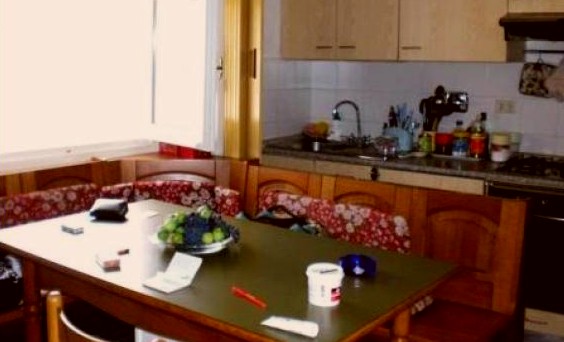
Thursday, December 12, 2013
Why Meredith Might Have Survived If The Attackers Had Cared And Called For Help Very Fast
Posted by Cardiol MD

Malala Yousafzai, world-famous Pakistani victim of a Taliban assassination attempt, survived via a tracheostomy
Absence of full medical picture outside Italy
For this post I wear my medical hat - I am a cardiologist who has had many lives in the balance under my hands.
Parts of the prosecution’s evidence back at trial in 2009 were very stark. Some was presented behind closed doors and with no CCTV feed, although good summaries in Italian appeared in the Italian press.
In Italy the reporting on the trial was several times as deep as anywhere else. There were TV chat shows to review the case as it was being made, and many in Italy read the entire Massei Report when the Department of Justice put it on their website.
Nobody in Italy gives the slightest credence to the theory of the Lone Wolf. Many or most have not even heard about it, and to almost all Italians the idea that Guede could have acted alone (as Knox and Sollecito claimed in their English-only books) would seem absurd.
Many Italians were therefore quick to realize that the Hellmann court did not see the prosecution present its real case, and had been led astray by cherrypicking and innuendo by the defense and an unqualified judge.
In contrast, as I said above, foreign reporting was not deep. The Massei report now being argued against by Knox and Sollecito (yes, this is THEIR appeal) has not yet been carried in English by even one non-Italian media site.
Even the amazing Massei report summary which PMF posters so carefully prepared appeared only here.
How this can affect the January outcome
Among the starkest items of the evidence that are well known in Italy but almost nowhere else are the autopsy findings and the whole-day crime scene recreation testimony.
They were presented (1) only in closed court in mid 2009 and (2) in the attack recreation video shown to the court late in 2009. during Summations. The highly effective video, which took months to get just right, was not entered into evidence and so no jury other than Massei’s has seen it since.
Closing this yawning chasm really matters now because (1) the Supreme Court is in no doubt that Guede did not act alone and (2) the Sollecito and Knox defense attempts to prove one or two other perps staged the attack with or without Guede have fallen off a cliff.
Here is the blunt truth:
- Meredith’s killers at the end inflicted terrible, terrible wounds, and witnessed what she went through.
- There is evidence that Meredith might have SURVIVED if medical help had been called very quickly indeed.
Instead of course her killers cruelly ignored her dying pain, took away her phones, locked her door, and for a while at least they simply went away, while she died.
These truths about the attack and in particular the horrific wounds is relevant both to what Meredith’s killers are guilty-of, and to what sentence would be appropriate if it is confirmed they did the deed.
Brief explanation of the medical facts
While this subject is tough for most people, it has to be viewed objectively by medical-professional care-givers and by judges, and now may be an acceptable time to objectively clarify the subject.
Such information is considered highly relevant in US courts, under Federal Rule 702. Testimony by Expert Witnesses, US state Good Samaritan Laws, and possibly in Italian courts, under Art. 593 of the criminal code ““ Failure to Provide Emergency Assistance.
Even though I can find no references to Failure to Provide Emergency Assistance in the various Motivazioni, many TMJK readers may be interested in this discussion of the subject:
MK’s airway-wound, taken in isolation, was certainly survivable for hours or even days; her superior thyroid artery wound was potentially survivable if simple manual compression was quickly applied there-and-then by anyone present, and urgent professional assistance was then obtained.
MK’s dying occupied at least as much as 15 minutes; it was the combination, and proximity of the 2 wounds that was lethal.
The kind of injury to Meredith’s airway, intentionally inflicted with malicious intent, is well within the spectrum of accidental injuries seen and treated in hospital ERs.
The elective therapeutic procedure - tracheostomy - has consequences very similar both to malicious and to purely accidental airway-injuries.
A tracheostomy is a surgical procedure to create an opening through the neck into the trachea (windpipe).
A tube is usually placed through this opening to provide an airway and to remove secretions from the lungs. This tube is called a tracheostomy tube or trach.tube.
The cutting part of the procedure is called ‘the tracheotomy’; ‘tracheostomy’ is the name assigned when the artificial tube has been inserted.
Tracheostomy is frequently performed in hospitals, all over the world. The subjects of tracheostomy cannot phonate unless the tracheostomy-opening is sealed, typically using a finger to divert the exhaled air through the larynx.
Injuries to the tracheobronchial tree within the chest may occur due to penetrating forces such as gunshot wounds, but are more often the result of blunt trauma. TBI due blunt forces usually results from high-energy impacts such as falls from height and motor vehicle accidents; the injury is rare in low-impact mechanisms.
Injuries of the trachea cause about 1% of traffic-related deaths. Other potential causes are falls from high places and injuries in which the chest is crushed. Explosions are another cause.
Gunshot wounds are the commonest form of penetrating trauma that cause TBI. Less commonly, knife wounds and shrapnel from motor vehicle accidents can also penetrate the airways.
Most injuries to the trachea occur in the neck, because the airways within the chest are deep and therefore well protected; however, up to a quarter of TBI resulting from penetrating trauma occurs within the chest. Injury to the cervical trachea usually affects the anterior (front) part of the trachea.
Notables who survived via a tracheostomy
Many public figures have received tracheostomy in the past. These are perhaps the most well-known:
- Gabrielle Giffords, a Democratic member of the United States House of Representatives received a tracheostomy after being shot in the head.
- Elizabeth Taylor had an emergency tracheostomy for pneumonia in 1961.
- Stephen Hawking (physicist) received a tracheostomy because his muscles of respiration are paralysed by Amyotrophic Lateral Sclerosis (ALS, also known as “˜Lou Gehrig’s disease’)
- Catherine Zeta Jones (actress) when a little girl, contracted a virus that prevented her from breathing normally, and underwent tracheostomy surgery.
- John Paul II (Pope) had an emergency operation after a breathing crisis
Others whose tracheostomy saved their lives
Medical and legal conclusions from this
Repair of Meredith’s airway injury was potentially survivable, given the conditions indicated in the medical text above.
It was the simultaneous severing of her right superior thyroid artery, and the failures not only to seek emergency care, but the abandonment by her attackers that resulted in her death.
The right superior thyroid artery is about the same size as the radial artery of the wrist, which when severed suicidally, leads to a similarly slow death from blood-loss alone.
In Meredith’s case, she inhaled the blood and died less slowly, by coexistent drowning.
The Nencini Court should take her killers’ Failure to Provide Emergency Assistance into account in its decisions, especially if they now try to claim it was just a prank-gone-wrong.
Malala Yousafza who survived via a tracheostomy; the tube is visible below her chin
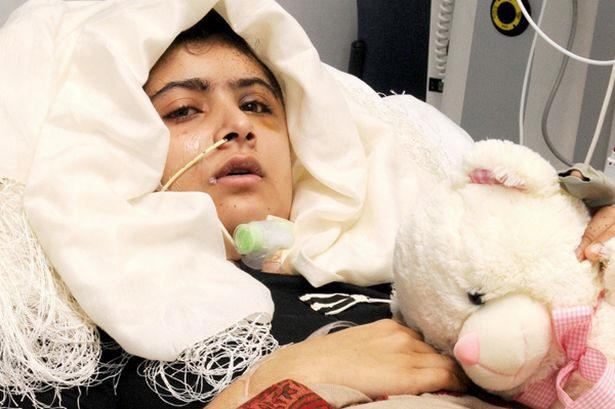
Monday, December 09, 2013
The Rise And Fall Of “Frank Sfarzo” And His Disastrous Trip To The US And Canada
Posted by Ergon
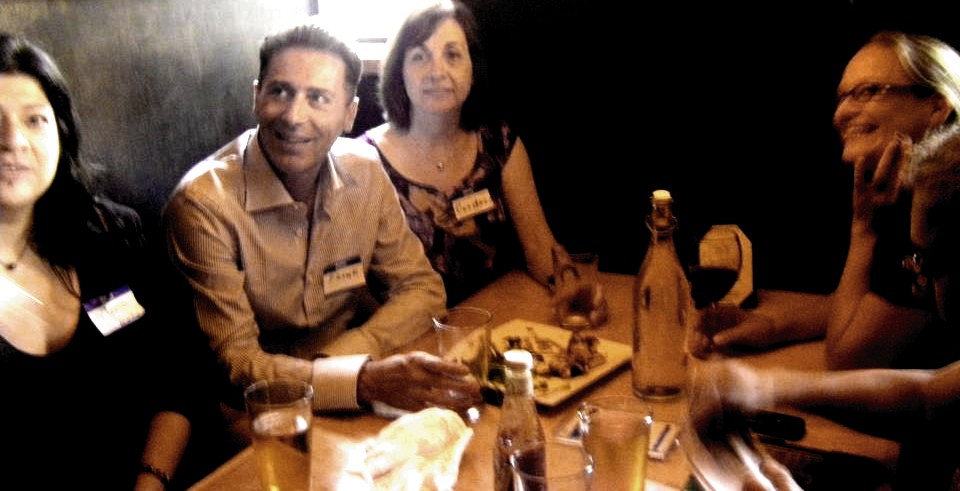
[Frank Sforza riding high in his first days in the US]
Part II on Frank
My Part 1 post in this series is just below this post, and others will follow. Much of this first emerged on PMF dot Net. TJMK has posted about Frank in early days, and about the Seattle court.
Who is the real Frank Sfarzo?
Born July 04, 1963, in Rome, his real name is Francesco Sforza. This is confirmed by his passport data which I saw. He tried for years to hide it, and it is of public interest since, when arrested for assault, he again, deliberately misspelled his name. Like Bruce Fis(c)her, he tried to hide his many slanderous and libelous accusations on his blog behind the handle ‘Frank Sfarzo’.
The son of a doctor (like Raffaele Sollecito) he got a degree in philosophy from the University of Perugia (Candace Dempsey, Murder In Italy). Then his peripatetic lifestyle took him from Florence to Naples, a stint in the US, and work as a director of production in the troubled 2006 movie And Quiet Flows The Don.
When the Meredith Kercher case broke late in 2007, he was the first blogger, on his new site Perugia Shock, to write about the case. Moving back from Florence to Perugia, he managed a student flophouse, then he lived with his mother in a flat paid for through her pension check - his pattern for some time had been to live off the patronage of women.
These articles are based on a series of posts I wrote on PMF dot Net - the SfarzoGate Papers. They are also based on interviews of many people who knew him personally - one common theme was how financially insecure he was, often to the point of stealing from their wallets/purses, and getting caught shoplifting from a local Coop store (September 06, 2010)

[Perugia Shock in 2008 stiil supportive of Meredith, sarcastic of Knox]
Insertion into the case
Despite receiving lots of moneys from US supporter networks for his local intelligence (I saw evidence that pointed to a leak from inside the Questura, for which the prosecutors began an investigation against him in January 2009) his big dream was a) to own property and b) write a book/movie about the case.
It was this that drove him into the arms of the Friends Of Amanda (see forthcoming Part III about their support for him and his blog Perugia Shock coming shortly) and to literally “˜turn on a dime’ in 2008 from being convinced of Amanda Knox’s guilt (he has always maintained Raffaele Sollecito’s relative innocence) to becoming, not just a pro-Amanda Knox blogger, but allying himself with the anti-Mignini forces in Perugia who wanted to impede his Monster Of Florence murder investigation.
The war upon Dr Mignini
The MOF series of ritualistic sex based murders took place in the Florence area in the 70’s, and it fell to the prosecutor Dr Giuliano Mignini, with ace criminal investigator Michele Giuttari, to carry on the work of earlier prosecutors. Much of the misreporting on the MOF case was sourced to Mario Spezi, who, allied with American writer Doug Preston, started a campaign of slander against Mignini from 2006 on that continues to this day.
My sources tell me that Frank knows Spezi quite well, and as well he is allied with the Berlusconi forces who wanted to carry out their attack on the Italian judiciary. But, seeing how Doug Preston supposedly got a movie deal with Tom Cruise’s company, then after that with George Clooney, to film The Monster Of Florence, he hoped to have a similar movie made about the Amanda Knox case, with him working on it of course.
Neither movie looks to be made now, which adds to much bitterness in some quarters.
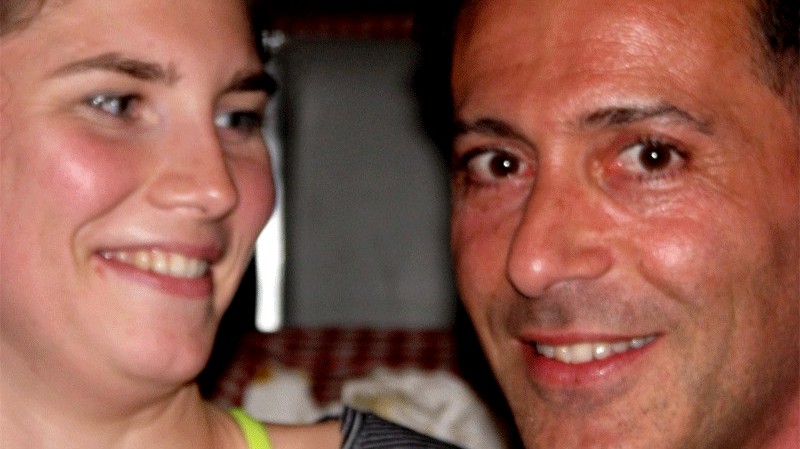
[Knox in Seattle with Frank; she came to mistrust him]
The Perugia domestic dispute
Then, as tends to happen, the wheels came off the PR bus. Frank’s sisters, concerned about how he was taking advantage of his mother, tried to intervene, he became abusive, the police were called for the domestic dispute September 10, 2010; he went ballistic, and attacked them.
It was this incident, with the resulting assault charge he has managed to avoid so far, that he has spun into a web of lies about “˜Mignini’s persecution’ with the assistance of his muse, Candace Dempsey, author of Murder In Italy, the Friends Of Amanda Knox and Bruce Fischer, the co-owner with Sarah Snyder of the for profit Innocence-Anywhere (formerly Injustice In Perugia) website.

[The initial accomodation the Mellases hoped Frank would accept]
His begging for money
His sisters having whisked his mother off to their own home, he was without funds and about to lose his apartment. From a begging e-mail of Frank’s, Feb. 23, 2012: “They knew my sister was against me, the women in my family are unfortunately bad, you guys are saving me, I will always be grateful, I will be filing the complaint to have “˜Piggy’ and his gang tried, I will write the movie about this case, we will do great things together”.
He also claimed it was his sisters who were stealing the family funds, and that Mignini’s actions in the Meredith Kercher case were “˜criminal’ (which is the reason for the criminal defamation lawsuit he must now appear for in Florence).
Pleas for financial assistance ensued, along with hints he might be closing down his rejigged website and moving to the United States for “other journalistic projects”. He actually asked for 10,000 Euros through Bruce Fischer’s website!
His attempt to move to US
The reality was, Italy beginning to pall, and with the outstanding assault charge, he hoped to make a permanent move to the US, with the help (he thought) of his prominent American supporters.
Funds began to flow, and by my estimation he has received “˜donations’ in the tens of thousands of dollars. Which never, sadly, was enough. Just one Canadian supporter, who was abused by Frank after arrival, sent him 7000 dollars (confirmation posted by him on dot NET) in the form of 500 Euro monthly payments, plus his return air ticket.

[The Vashon Sportsmens Club where Frank & the FOA met]
Frank arrives in Seattle
The supporter gave the date of his arrival at Seattle Air Port July 20, 2012, along with fellow Knox supporter Dr. David Anderson, with whom he’d been staying in Perugia.
Frank managed to invite himself to the Mellas household, promising to reveal all about the investigation that would blow it wide open. He also claimed to have copies of the Amanda Knox “˜interrogation’ by the police and PM Mignini, which also, turned out to be a lie.
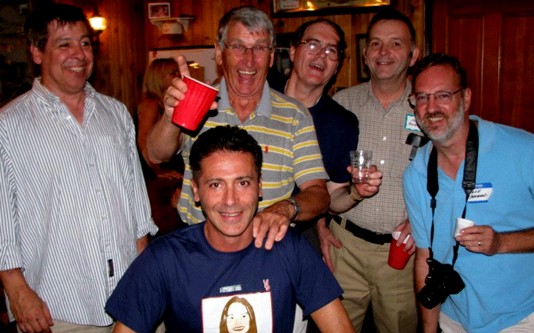
[The FOA publicity planning meeting inside the bar]
His first accomodation
Offered a bunk in Chris Mellas’s boat parked in his driveway, he threw a fit, and demanded to be housed in their home.
Where he ended up, staying with them for two months beginning July and including the Canadian interlude. Judge Michael Heavey who also had been sending regular monthly contributions (I am told around 300 Euros) escorted him around Washington State, then took him and Dr. Anderson to another of his pro-Knox anti-Mignini Rotary Club Club meetings on July 25, 2012.
The problem was that the Mellas clan and Bruce Fischer had already planned the big Vashon Island get together at the Vashon Sportsman’s Inn, Saturday July 28, 2012, to plan and coordinate the PR push for the shortly to be released books, and thank her supporters.
Therefore, not wanting to risk a blowup, they tried to placate him, while complaining to themselves about his behavior.
Knox stepdad Chris Mellas even told the Canadian supporter that Frank was a “˜difficult house guest’, this a week after he’d arrived (!) while Candace Dempsey, sitting next to them, nodded agreement.
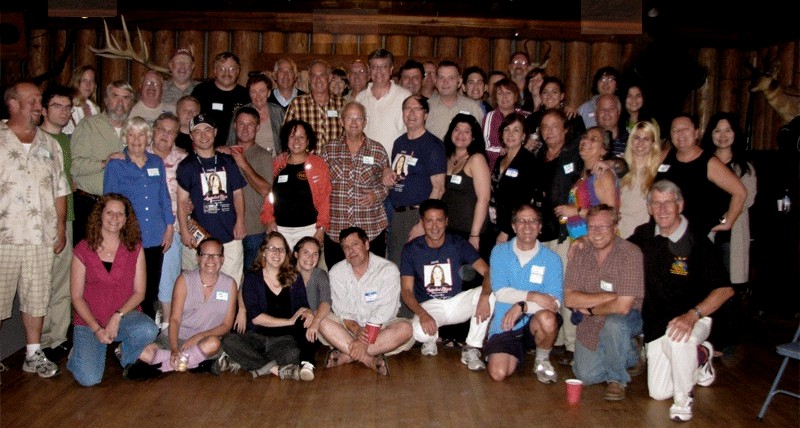
[The FOA publicity group photo inside the bar. Some in hiding, we have other photos]
Frank Sforza and Amanda
Frank sat all day next to Amanda, who seems in her pictures to have a horrified fascination with Frank, who posed front and center for many group photos, and grandiosely boasted how he was going to “˜reveal all about the gang of criminals’.
The supporters, who numbered over 60, including Judge Heavey, Steve Moore, Tom Rochelle, Joe Bishop, and Bruce Fischer, all lapped it up. Later, when the infamous finger salute Group Photo was taken, it was with the instruction to “send a message to Mignini”. Shouts of “Pignini” rang out.
Frank was working very hard after that to find a way to stay in the US. He looked into obtaining a Green Card, but most of the female supporters were already married/not interested. Photos taken of him with them at the time show an adoring, rapturous group, though that changed after the stories came out.
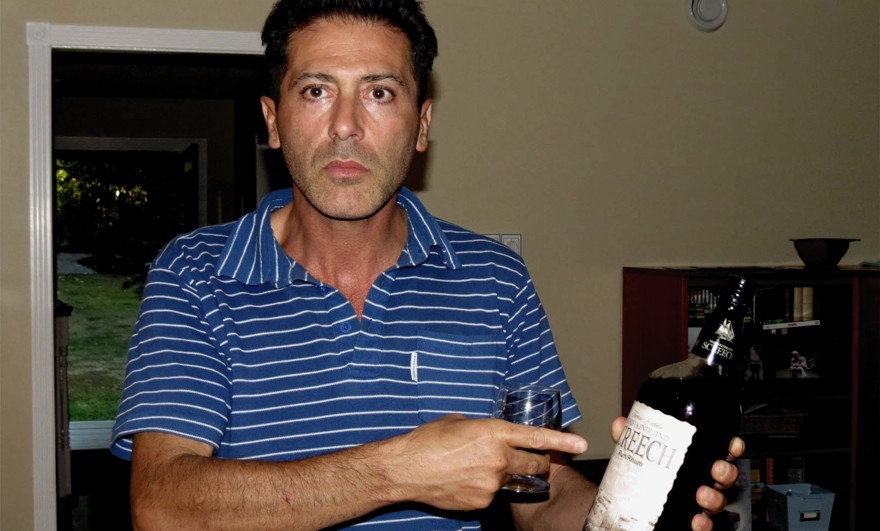
[Frank points to Screech Rum bottle from “Bill Williams” in kind host’s house. He looks very angry]
Frank’s Canadian interludes:
His first visit over the border for a week, went well. His Canadian supporters, one of whom, “Bill Williams” (a Canadian reverend) posts thousands of Groupie posts, met him with a bottle of “Screech Rum”.
The second visit, though, was when it all began to unravel.
A Canadian border service agent intercepted Frank, and, not believing his story why he was visiting Canada, seized his passport, and ordered him to report back to the agency the next day, August 25, with his Canadian sureties, “Bill”, and “Peter”. He was allowed to stay over, but things began to unravel after that. (I saw the passport seizure document)
Frank became increasingly erratic. Not satisfied with the money already received from his host, “Peter”, he requested a “˜business loan’ of $25,000 to set up a beach bar. “Peter”, a successful retired businessman, was struck by Frank’s lack of business acumen, said the plan was unfeasible, and declined.
Frank Sfarzo, who had never held a long term job or owned property in his life, began to insult him, calling his $750,000 home a “˜barn’ and other personal insults. Yet all he did in the nearly a month he was there was watch soap operas all day long, plus work on his blog, which his supporters helped him edit.
In the end, when one of Frank’s tirades became too unbearable, his host, concerned for his safety, called the RCMP at 4:00 AM in the morning, who then escorted Frank, uttering threats of “suing” everybody, to the border, and expelled him from Canada. He is now barred from entering the country. In turn, Frank accused his 71 yr. old host of sexually molesting him! The police didn’t believe him, of course.
Frank is back in Seattle
Frank returned to Seattle, where he was asked to leave the Mellas home after making a pass at Amanda Knox. Chris Mellas famously called him a “mooch” and an “exploiter”, and asked the Hawaiian supporter to delete Amanda’s personal information from Frank’s telephone, but everyone was too scared of him to do much else.
Frank then stayed a few days Edda Mellas’s sister, Janet Huff’s home (he calls her and her daughter a “˜bitch’) then various homes until he ended up in a rooming house owned by another supporter, at 2283 Viewmont Way W. Seattle, on a three month lease beginning October 01, 2012 at $525 a month (paid for by the FOA, Frank’s funds were running low)

[The hotel where Franks kind host paid his bill]
Frank’s Hawaiian adventure
Frank’s visitor’s permit running out, he accepted an invitation from another American supporter, then a long standing member of Bruce Fischer’s forum. He thought she was rich, she thought he was a misunderstood soul who corresponded with her regularly (she paid for a month’s rent, sent a ticket as well to Kona airport).
Frank arrived November 08, 2012, on a seven day ticket. He was due to return November 14, but his plans were to get married, and obtain a Green card.
Surprise. She wasn’t rich, wasn’t interested in marriage, and lived off the land in a little mountain community. He started the usual pattern of verbal abuse. They were peasants, she was a “˜loser’, etc. The people there were going to beat him up, she saved him from that. Even the dogs hated him.
Trying to salvage the trip, she took him to a hotel room (which she paid for) for the last day on the island. Frank started with the abuse again, struck her, she fled to the desk and called the police. She just wanted him removed and to catch his flight, he threatened to sue the police, they arrested him for assault. He claimed she threw luggage at him, but it was she who had the bruises to show to the police. She fled the room right after.
He was held overnight, released the next day and told to appear in court the next week on assault charges. Which he did, and she, just wanting to have him leave the island, declined to press charges, which can still be reinstated, should she chose to do so. Copies of all his arrest warrants and charges have already been published on PMF dot NET and PMF dot ORG.
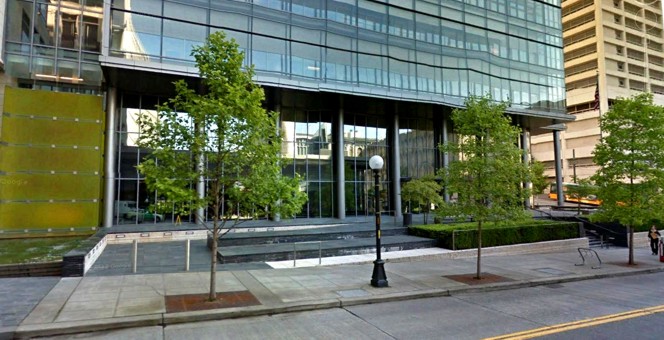
[Seattle Municipal courthouse where Frank was supposed to attend trial December 31, 2012]
Denouement:
When the news of his arrest broke, there was shock all around at PR central and Bruce Fischer’s ORG. Bruce tried to cover it up, deleted his forum member’s allegations (I found and saved it in the hour it was up)
I expressed sympathy on PMF dot Net, she read it, contacted me, and the rest, as they say is history. Bruce tried to intimidate her by revealing her past sexual history, which Frank passed to him (so she posted it herself, she’s a victim of sexual assault, and decided she didn’t ever want to be a victim again)
Then when Peter, the Canadian host spoke up on her behalf, Bruce tried to pass it off as “˜just too much to drink on both sides’ and this caused an uproar in his own forum, as members, appalled, quit in droves. And some of them, contacted me.
Of course, Bruce, who likes to intimidate and abuse, (as former friend Steve Shay found out) allowed Knox “˜family friend’ Karen Pruett to reveal the accuser’s identity, even though we had obscured her name in our reporting.
Frank got into an argument with two men at the rooming house who called him out on his behavior, he sucker punched one from behind and bit another, a disabled person. He was arrested and charged with assault, held overnight, arraigned the next day, probable cause found, and he was told to appear in court December 31, 2012. Which he didn’t, having fled back to Italy.
Just like in Hawaii, he provided false ID and was charged as “Francesco Sforca” though we were able to locate the court records anyway. His supporters say he was stopped at the border from returning, but that is a lie. He was in Italy throughout that time, my sources tell me. Someone is out $2,500 bail money.

[Seattle airport where Frank took off from after arrest, never to return]
Postscript
Francesco Sforza, also known as Frank Sfarzo, who travelled with and left behind files, photos and videos of a murdered girl in three different cities, should know that all his “˜property’ has been forwarded to the authorities to return to their rightful owner, whoever that might be. I do not know whether that forms or is part of an investigation into his activities, nor do I care.
(To be continued in Part III, Frank Sfarzo and the FOA, due sometime this weekend)
Friday, December 06, 2013
After 6 Years Heavey Is Still Heedless Of His Errors Pointed Out Again & Again & Again
Posted by pat az
1. Overview of this post
Michael Heavey has a considerable record of interventions that seriously mislead.
He makes false claim after false claim after false claim. Often corrected, he heedlessly gravitates no closer to the truth.
This post corrects a misleading and dishonest letter from Heavey to President Obama copied to Congress of 16 May 2011.
1 Misleading interventions in 2008
During this year Heavey (then still a judge, though one who was merely elected - nothing compared to the rigorous process Italian judges must go through) sent three erroneous open letters (posted on the web and widely copied) to senior justice officials in Italy about the case.
TJMK posted on the errors in December 2008.
2 Misleading interventions in 2009
By way of interviews in the media, Heavey continued his campaign. He has claimed that his motives really are noble: in effect, Knox could have been his own daughter, though his daughter has distanced herself from this campaign.
3 Misleading interventions in 2010
One of the 2008 letters to Italy was sent on official judicial letterhead, as if he was speaking for the State of Washington. In 2010 the Washington State Commission on Judicial Conduct disciplined Heavey although it was only for an illegal use of the official letterhead, not for wrong claims.
The initial announcement was posted on here. The details of the charges were posted on here. The disciplinary penalty was posted on here.
4 Misleading interventions in 2011
In April 2011, one month prior to his misleading letter, Heavey was a droning presence on a panel before an audience of 35 at Seattle University. His familiar talking points were again repeated.
It is cross-posted from my own website here. Links to previous posts about Heavey on TJMK for the period 2008 to 2011 appear at the bottom of this post.
2. The 16 May 2011 letter to President & Congress
On May 16, 2011, Judge Heavey (now retired) apparently sent US President Barack Obama a letter regarding the Amanda Knox case.
This document was retrieved from the King5.com news site under a search result for “Amanda Knox.” The subject of Judge Heavey’s letter was “Re: Failure of Rome Consular Officials to protect the rights of U.S. Citizen Amanda Knox.”
The new Heavey letter was written on letterhead “From the chambers of Judge Michael Heavey.” The address given is his house address.
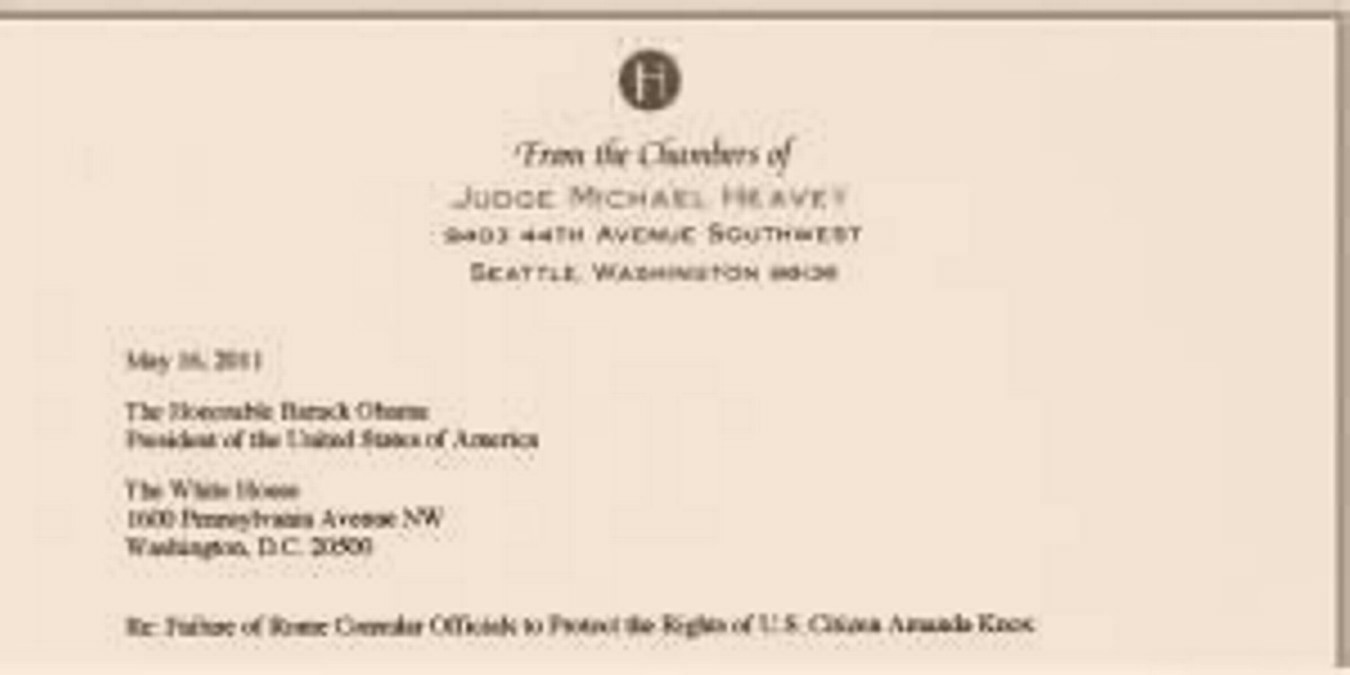
The Judge charged that the State Department absolutely failed to look out for the rights of Amanda Knox. Nowhere in the letter does Judge Heavey actually address any of the evidence in the case.
Ten times in his letter, he charges consular officials failed to take action when they should have.
However, many of his points are false or misstate the events. In many instances, Judge Heavey is proven wrong by statements from Amanda Knox herself.
This letter, full of errors, was carbon copied to Members of Congress AND the Secretary of State (at the time, Hillary Clinton).
These mistakes would have known at the time Judge Heavey wrote his letter by using the interviews and documents available at that time. This did not stop Judge Heavey from writing an error-laden letter to the President and Congress. These errors are detailed below.
Additional signatories to the letter (on letterhead from “from the chambers of Judge Michael Heavey”) include Friends of Amanda representative Thomas L. Wright, and author of “The Framing of Amanda Knox” Dr. Mark C. Waterrbury.
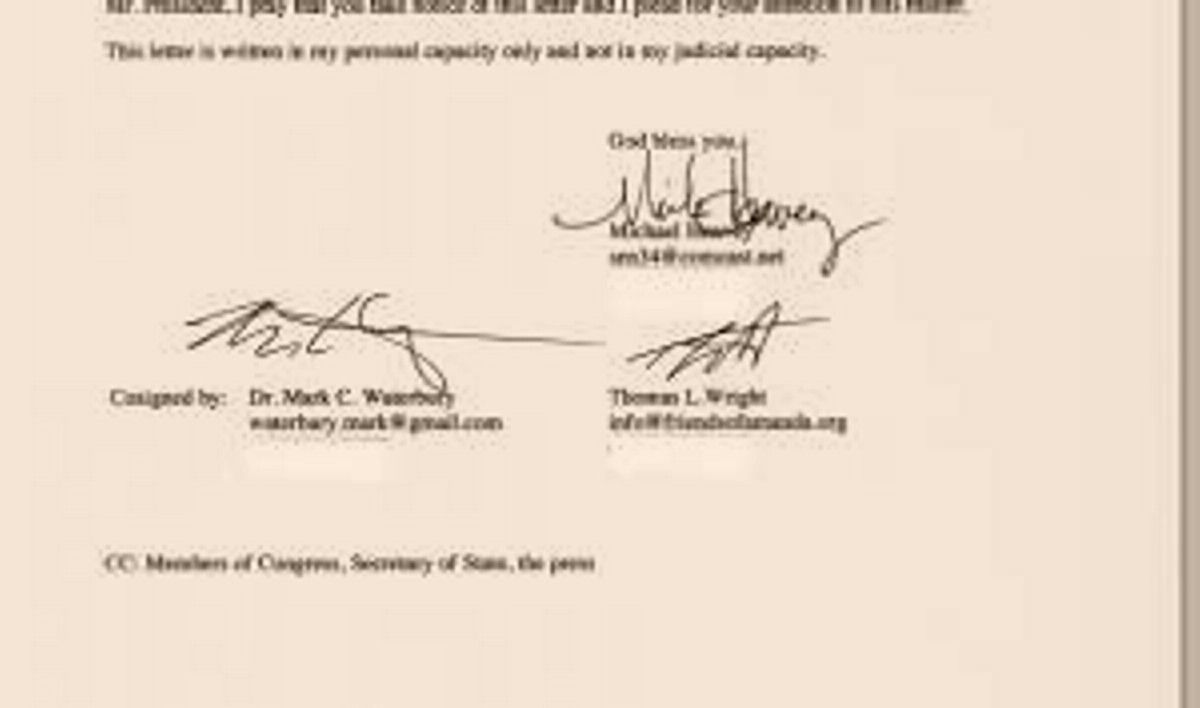
Judge Heavey had been admonished for using court resources and stationary as a part of his advocacy in the Amanda Knox case, as well as his public speeches while he was a sitting judge.
The admonishment only covered the letters written to Italian court officials and prosecutors, using court stationary and court staff. The letter he apparently sent to Obama and congress was not included in the admonishment.
The following is a point by point review and rebuttal of the by-now admonished Judge Heavey’s Letter to President Obama and Congress
1. False brutal interrogation claims
The letter opens up with a summary of the argument- that this case was a prosecutor’s vendetta against Amanda Knox, and that her rights were violated, and Consular officials did nothing. The letter is arranged as a series of points, which are discussed below.
Judge Heavey writes: “Amanda Knox was arrested for the murder of her roommate after an all-night interrogation [...]. The Perugian Police denied her food and water, cuffed her on the back of the head, and, most importantly, prevented her from sleeping.”
However, Amanda Knox was not the one called into the station. Raffaele was; and they went right after having dinner!
A UK based paper had published the day before an article with quotes from Raffaele. Raffaele said he and Amanda went to a party on the night of the murder. Police were likely calling in Raffaele due to the conflicting stories.
Amanda’s “interrogation” didn’t start until at least 11pm. Police have testified she was offered food and water. She went to sleep after signing her second statement, at 5:45 am. There was a break between signing her first statement at 1:45 am and signing her second statement (after being warned by Dr Mignini to say nothing further without a lawyer) at 5:45 am.
Here is Amanda Knox:
“Around 10:30pm or 11pm Raffaele and I arrived at the police station after eating dinner at the apartment of one of Raffaele’s friends. It was Raffaele who the police called, not me, but I came with him to the Questura anyway while he was to be questioned for support, as he had done for me many times.” -Amanda Knox, letter to lawyers, 9 Nov 2007
“I signed my second “spontaneous declaration” at 5:45 AM [...]. I asked permissions to push two metal folding chairs together, balled myself into the fetal position, and passed out, spent. I probably didn’t sleep longer than an hour before doubt pricked me awake”¦ “ -Amanda Knox, Waiting to be Heard
To this day, Raffaele Sollecito has not corroborated Amanda Knox’s alibi in court.
2. False no-lawyer claim
Judge Heavey writes: “When a witness becomes a suspect, the police are obligated to appoint a lawyer”
Knox was not a suspect and the interview was merely a recap/summary session with someone who might have information as the defenses themselves agreed. Knox herself twice declined a lawyer before insisting on writing three statements out.
Prosecutor Mignini was interviewed by CNN ten days before Judge Heavey wrote his letter. In the interview, Mignini describes the questioning of Amanda:
“And thus her interrogation as a person informed of the facts was suspended by the police in compliance with Article 63 of the Italian Code of Criminal Procedure [c.p.p. - Codice di Procedura Penale], because if evidence appears that incriminates the person, the person being questioned as a person informed of the facts can no longer be heard, and we must stop. “Everyone stop! There must be a defense attorney [present]”. And thus the police stopped and informed Amanda” -
Prosecutor Mignini, CNN interview, May 6 2011 (Ten days prior to Judge Heavey’s letter)
Thus, it was known on national television in the US what the sequence of events was. This did not stop Judge Heavey from writing an error-laden letter to congress.
3. False no-recording claim
Judge Heavey writes: “Article 141 of the CCP requires that every interrogation of a person in custody (for any reason) must be fully recorded by audio or audiovisual means”
However, Amanda Knox was not in custody during her questioning on Nov 5th & 6th. She was not a suspect, and this was not a suspect interview. She merely eagerly listed seven names. She was only at the station because Raffaele was called:
“It was Raffaele who the police called, not me, but I came with him to the Questura anyway while he was to be questioned for support, as he had done for me many times. “
-Amanda Knox, Letter to Lawyers, 8 Nov 2007
4. False no-interpreter claim
Judge Heavey writes: “Amanda spoke little Italian, yet was not allowed to have an interpreter to assist her with understanding the questions put to her, the charges against her, or anything else.”
Two sources refute Judge Heavey’s point- official court records of the questioning, and Amanda Knox’s own statement on trial and in her book:
From Court documents
“...assisted by the English-speaking interpreter Anna Donnino” -Signed 1:45 AM statement.
“....assisted by the English-speaking interpreter Anna Donnino” -Signed 5:45 AM statement.
And from Amanda Knox:
November 2nd: “”¦they brought in an english-speaking detective for hours two through six.” -Waiting to be Heard
November 4th: “AK: So, it seems to me that Laura and Filomena were there, but they had arrived with other people, while I was in the car with the police and an interpreter, that’s it.” -Trial Testimony
November 5th/6th: “The interpreter, a woman in her forties, arrived at about 12:30 A.M.” -Waiting to be heard
5. False vengeful prosecutor claim
Judge Heavey simply engages in a character assassination of Prosecutor Mignini:
“[...] Mignini was well known in Italy for a bizarre theory [...] under investigation for abuse of office [...] previously driven American journalist, Douglas Preston out of Italy[...]”
Judge Heavey, Dr. Waterbury, and FOA representative Thomas Wright conclude point five with:
“Consular officials knew Mr. Mignini was prosecuting Amanda Knox. They knew he had been charged with abusing his office. They knew of the bizarre theory that he pursued, from which the charges arose. They also knew he was under tremendous pressure to achieve some vindication to save face. Why did consular officials do nothing?”
The trumped-up charges against Prosecutor Mignini pursued by a rogue prosecutor ad rogue judge in Florence were overturned by the Florence appeal court and sacthingly roasted by the Supreme Court. Dr Mignini (now Deputy Attorney General for Umbria) was under no pressure at all. See this post here.
6. False satanic myth claim
Heavey and others raise the satanic ritual myth quoting Prosecutor Mignini as stating at the October preliminary hearing, “the crime was a sexual and sacrificial ritual in accordance with the rites of Halloween.”
The ONLY source for this quote is a defense lawyer for Sollecito who made it up. Judge Heavey then turns around and uses this metaphor himself:
“these and other statements should have shouted to consular officials that Amanda was a defendant in what had become a witch trial, being prosecuted by a delusional prosecutor. Why did consular officials do nothing?”
7. False US Embassy claim
Despite Heavey’s claims, US consular officials WERE monitoring the case, as revealed in FOI-released documents requested by journalist Andrea Vogt. She released these documents in a May 2013 post on her website.
This is clear: consular officials regularly visited Knox and tracked case developments. The following diplomats’ names appear on the cables: Ambassador Ronald Spogli, Deputy Chief Elizabeth Dibble and Ambassador David Thorne, U.S. Embassy Rome.
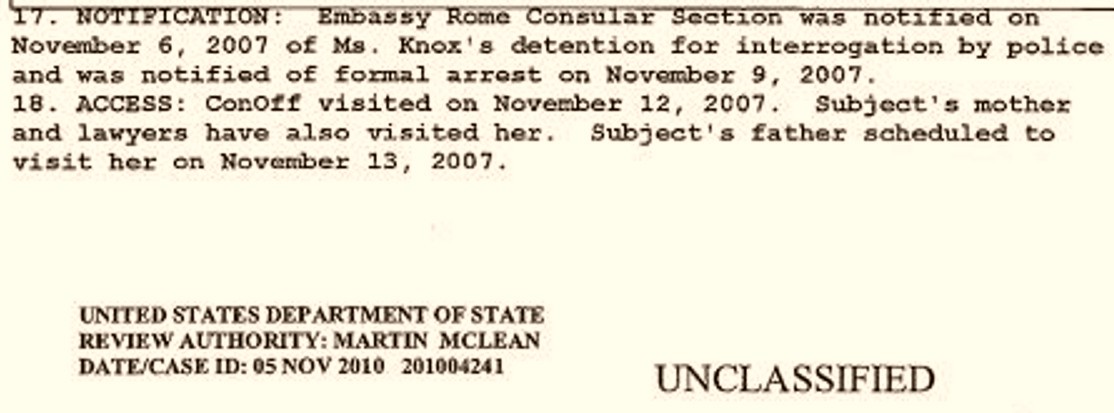
The US Embassy cables that were released were dated: Nov, 07; Dec 08; Feb 09; May 09; Aug 09; Nov 09; Dec 09. No other documents were released.
Consular staff visited Amanda Knox on November 12 2007, and noted her lawyers had already visited with Knox. The charges against Amanda Knox as stated by the US Embassy were:
* Participation in Voluntary Manslaughter with aggravating circumstances of cruelty
* Participation in sexual assault
* Simulated robbery
* Slander
* Possession of weapons
* Aggravated theft.
Over four years from late 2007 to late 2011 we estimate that the US taxpayer paid $400,000 for the Embassy’s monitoring of Knox.
The Rise And Fall Of “Frank Sfarzo” And How “Sfarzogate” Ripples On And On
Posted by Ergon
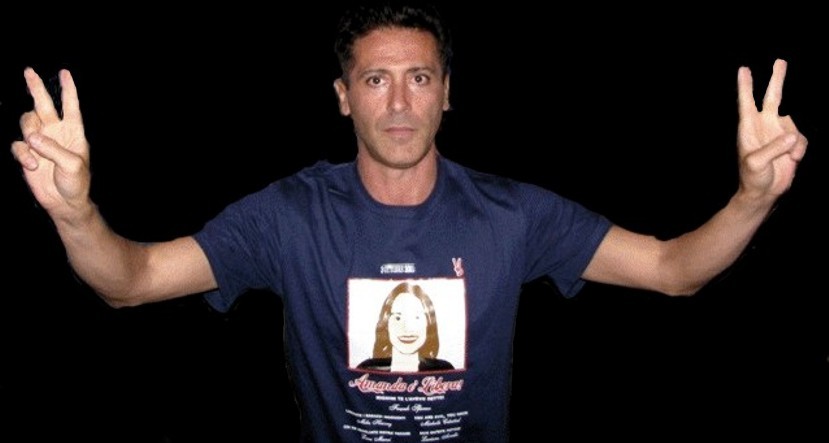
[Image is from Francesco Sforza’s early days in Seattle last year when he felt he was riding very high]
December 06, 2013. Francesco Sforza also known as Frank Sfarzo is due to appear today in a Florence criminal court.
He is charged with aggravated defamation (art. 595 of the Italian Criminal Code) against the Deputy Prosecutor General for Umbria (Perugia’s region) Dr Giuliano Mignini, because he is a very senior officer of the court, with the alleged intention of obstructing justice on Knox’s behalf.
The charges refer to multiple accusations of criminality Sforza made online on his now hidden or defunct blog “Perugia Shock”. A prison term is unlikely if found guilty at this one trial, but the problem is that he faces a trial for violence against police in Perugia as well.
Who is Frank Sfarzo? Is he “a Perugian blogger and investigative journalist” and “personable black haired man with intense brown eyes”? (Candace Dempsey, who relied extensively on his personal contacts and blog for her book “Murder In Italy”)
Or as journalist Andrea Vogt wrote in a May 27, 2009 Seattle PI article,
Dempsey was one of the first U.S. bloggers to post key court documents. (Sourced from Sfarzo) She is now writing a book on the case. The other defense site is Perugia Shock, the first blog about the case, which started Nov. 2, 2007. Perugia Shock’s comment threads are home to some of the most heated Knox-related exchanges online.
Perugia Shock is hosted on a California server and financed by an American firm, according to the Perugia-based blogger who covers the case and operates the site under the alias “Frank Sfarzo.
“Also known as Frank Sfarzo, this home-spun blogger set up his blog “Perugia Shock” the day after (sic) Meredith’s body was found. The Knox family initially relied on his local intelligence, and he exchanged videos and information with pro-Amanda Seattle blogger Candace Dempsey”. Source: Darkness Descending page 324.
The journalist Barbie Nadeau has this to say about Sforza in “Angel Face” pages-89-91:
The first blog dedicated to the crime, Perugia Shock, was set up on November 02, 2007, the day Meredith’s body was discovered. The blogger, Frank Sfarzo, a skeletal man with a waxed crew cut, ran a student flophouse in town and believes that he missed a call from Meredith while she was looking for lodging.
When I later asked him in an e-mail why he started the blog, he explained the connection and described how Meredith had looked at the coroners: “Seriously, she was so beautiful and sweet, she seemed to be alive, with the mascara on her eylashes (sic), just like ready to go out.
“Sfarzo hid behind the handle, “Frank the blogger,” and he would never confirm whether he actually saw Meredith on the autopsy table or simply saw the coroner’s photos. (He saw the photos, and obtained copies) He ingratiated himself with several clerks and cops around town and, curiously, often had a document no one else could get or a scoop that beat out the rest of the press.”
He started out as an objective observer, slightly sympathetic to Meredith, but became a rabid proponent of Amanda’s innocence. He was the quintessential blogger—a smart, cryptic, insomniac. Even the chief prosecutor, Giuliano Mignini, read his posts.
Mignini always believed that Frank’s blog was intellectually inspired and financially subsidized by Mario Spezi, the Italian journalist who covered the Monster of Florence serial killer for La Nazione. During the 1970’s and 80’s, several couples were murdered as they made love in their cars in the foothills around Florence. Spezi followed the investigation for years and pinned his reputation on a theory of the case that Mignini disputed. Eventually, Mignini had Spezi jailed for obstruction of justice and tampering with evidence.
Note: this is how the American fiction writer Douglas Preston got involved with Spezi, and latched on to the Meredith Kercher murder case as a way of getting back against Mignini, also supporting Frank Sfarzo behind the scenes.
Why is Frank Sfarzo so important to this case? It is about public perception about the guilt, or innocence of Amanda Knox and Raffaele Sollecito, and how he was the source of many of the myths about the case and prosecutor Giuliani Mignini that have made it into the mainstream media. Yes, he had many police files, improperly obtained, and insecurely kept.ïŠ
This article is the first of a series of posts about his activities in that regard, the true story of his so called “˜persecution’ by Dr Mignini, and the financial and other support he received from the supporters of Amanda Knox and Raffaele Sollecito, and their families. He even hid his relationship with OGGI magazine.
It reveals why he really fled Italy to America, attempting to get a green card in the process, and the many cases of assault that are still outstanding against him. It details the story of his arrests for assault in Perugia, Hawaii, and Seattle, and the circumstances of his expulsion from Canada.
It will tell how he received tens of thousands of dollars in “˜donations’ from prominent supporters of Knox and Sollecito funneled through Bruce Fischer’s organizations “Injustice in Perugia” and “Injustice Anywhere” as well as his and other people’s PayPal accounts (I have the details) And it will detail the behind the scenes efforts to influence the case using Frank Sfarzo as a source for the allegations against Mignini through websites like IIP and Ground Report, which then made its way into the media.
This series will also reveal much about Frank Sfarzo, the man. Someone who believed primarily in Knox’s guilt (with Sollecito as the roped in sex-slave) it shows a flawed being willing to compromise himself to make money, and also, fulfill his long held dream to have “˜books written and movies made’.
In the course of this investigation, I met with and interviewed many previous supporters who now wish they had never met him, and some, who even, conclude that his reporting on the case was based on self-serving lies. The behavior of those that enabled him also comes under scrutiny, and, their attempts to intimidate people into not speaking up about his actions.
They indeed, had much to hide.
This report is based on the hundreds of posts I made on him at PMF dot Net, with much help from the posters and editors there and at PMF dot Org. It was heartening to see the cooperation between the two sites and thanks are due to them, and also to Peter Quennell, who first invited me to join the Meredith Kercher community three years back (I’d been posting on the case at Huffington Post previously)
What will happen to Frank in court? I do not know, but it does appear, that the falsehoods he spread are beginning to unravel. I see he has surfaced again, after hiding from the authorities for so long. Reporting on Bruce Fischer’s blog, he writes “they attack me for speaking up”. No, I’m sorry. In this, as it always has been, the blogger Francesco Sforza, also known as Frank Sfarzo, is the author of his own misfortune.
Part II of the series, “The Sfarzo~Gate Papers”, will be published here next week. ~Ergon
[Below: This picture has a story behind it. Frank Sfarzo stayed almost two months at the Mellas household, and was later shunted off to various supporters when he made a sexual move on Amanda Knox.]
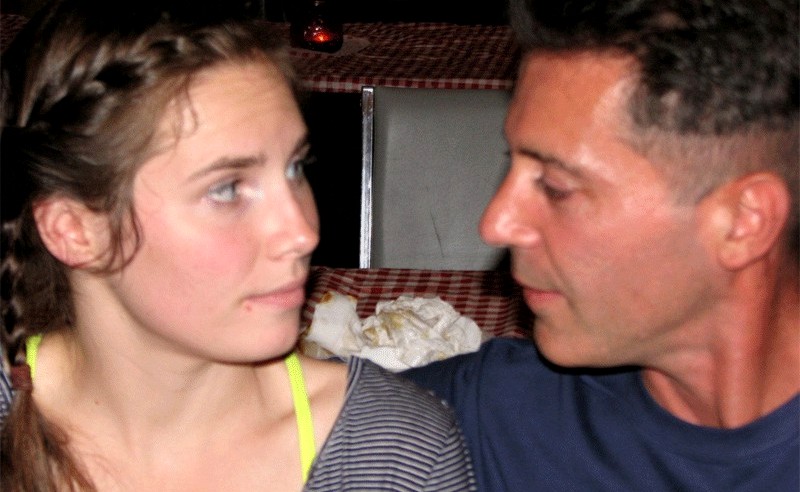
Thursday, December 05, 2013
With Sollecito’s First Plea For Mitigation Seen As A Flop, His Behavior Seems Extremely Suspect
Posted by Peter Quennell

Sollecito headed for Dominican Republic, but stopped pending court okay
1. Post Overview
A week ago Prosecutor Crini had begun a two-day summary of the state’s case so stark and implacable that it had two effects on Sollecito.
He stayed in his hotel on the second day; and he then took off like a rabbit for some destination initially unknown and repeatedly lied-about by his father (see Part 3 below).
One of his lawyers (accidentally?) broke the secret. Sollecito had flown to the Dominican Republic. Where he just happens to have some really unsavory relatives.
2. High Drama In The Nencini Court
Sollecito has not ever taken the witness stand.
And given the minefield his foolish book and media claims amount to, don’t hold your breath expecting otherwise soon. However, last month Sollecito did use the Italian accuseds’ privilege of making an impromptu plea to the judges.
He was not under oath and not subject to cross-examination by the prosecutors. He did not address the copious evidence, and was seen as attempting to humanize himself to perhaps get some years knocked off a final sentence.
As always, Knox forces were left confused, thinking he had somehow helped both of them. But Sollecito repeatedly drew attention to his being an Italian and in effect to Knox and Guede not being Italians, thus once again separating himself from Knox on lines Barbie Nadeau also described here..
Our main poster Yummi was in the court and reported in part as follows:
One of the woman judges kept staring elsewhere and almost never watched Sollecito all the time he was talking. Sollecito’s speech itself was actually not that exciting. It was so overt that he was focused on portraying himself as a person who is so good and cannot hurt anyone, not the bad guy described in the media. The real and only topic of Sollecito’s statement was himself, who he is, his “true” personality, he begged them to look at what a good and suffering a boy he is…
And believe me, Sollecito was just whiny. For a big part of his speech he was just putting distance between who he is today and the person he was when he was 20 years old. He talked about the impossibility of finding a job (the job he would like to have in a corporation, obviously, not just any job) and wanted the judge to project to his condition from that of young Italians who can’t hope to see a future.
Then 10 days ago the skilled senior prosecutor Dr Alessandro Crini fired back, and effectively demolished Sollecito’s premature statement. As we reported, Dr Crini took nearly two days to do that.
Sollecito was again in court on the first day, but was seemingly unable to face Dr Crini’s onslaught on the second day. He remained holed up at his hotel.
Although Dr Crini settled on a lowest-common-denominator motive - a Lord of the Flies flare-up which had escalated into mob violence and the fatal stab to Meredith - his recounting of the evidence and associated behavior of the pack was comprehensive and very hard. Translated from Cronaca:
Meredith was treated “as if she was an animal.” In this way Dr Crini defined the dynamics of the murder of Meredith Kercher during his indictment.
According to Dr Crini, the attack escalated to the point where the attackers felt they “needed to get rid of a girl they had abused”. While Rudy Guede sexually abused Meredith Kercher, supine on the floor of her room, Raffaele Sollecito and Amanda Knox, according to the reconstruction, were at each side of the body of the victim.
“The mouth and neck of the victim were contained in a fierce way to avoid Meredith going berserk and screaming, and when Meredith did in fact manage to scream, she received the final fierce stab to the throat.” Two knives were used in the crime at the house in Via della Pergola on the night between 1 and 2 November 2007”...
Dr Crini referring to the bra clasp of the victim, said that “the presence of the DNA of Raffaele Sollecito is quite certain” and explained at length why there was no “possibility of contamination”.
Amanda Knox was at the scene of the crime, according to the identification made “‹”‹by the scientific police in Meredith’s room of an imprint of a shoe (female size 36-38 according to the results of the analysis)... On the pillowcase, the center of gravity of this bloody history, were found a palmprint of Rudy Guede and this print of the shoe.”
3. High Drama Right After End Of Court
Dr Francesco Sollecito was reported as being shocked by the unrelenting tone of the indictment. However, Sollecito’s plight is not nearly as bad as the ever-stubborn Amanda Knox’s.
Knox has already served three years and was fined heavily for obstruction of justice. She could face another year for that if it is found to have been aggravating. And as the post below mentions, she could face as many as three more charges for aggravating obstruction of justice.
Sollecito in contrast has respected the court by actually showing up, and, unlike Knox, has lately shown restraint in accusing his accusers.
However, the day after Dr Crini ‘s startlingly powerful summary of the case against him, it looked like Sollecito was hastily taking off out of Italy for somewhere.
La Nazione reported that police at Florence Airport had held back a fully loaded Air France flight to Paris while they checked with the prosecution that he was indeed allowed to leave the country. La Nazione said the prosecutors have some concern that he might skip and not come back, but he did voluntarily come back previously from the Dominican Republic, and his family has always ensured some presence in court.
But next TGCom24 reported that Sollecito’s father had claimed that Sollecito had already gone home to Bisceglie, although he is a free citizen still in possession of a passport and can travel anywhere if he wishes.
But then TGCom24 reported that he had indeed flown to Paris, but had turned around and come straight back again, to stay with family friends. And that on 8 December he will sit his final exams in computer science at the University of Verona.
However, soon after that La Nazione reported that Sollecito’s father had been contradicted by his lawyers, and his erratic son had slipped through his fingers and flown “for his work” back to the Dominican Republic. Translation by Jools:
1 December 2013 ““ SCOOP. Denials, lies, game by the defenders. But in the end it’s up to the lawyer Luca Maori to admit: “Raffaele Sollecito returned to Santo Domingo, as anticipated on Friday by La Nazione”
He embarked from Florence’s Peretola Airport and made a stop-over in Paris, from where he then flew to the Caribbean island where he spent the last few months that preceded the start of the new appeals process. “But there is nothing strange - minimizes the lawyer - Raffaele went back to pick up the things he left there, will be back in ten days for the final exams and to await the judgment. With anxiety, but self-assured.”
No escape, just a normal “work” trip. Permissible, since there is no measure that prevents the accused to leave Italy. But the departure of Sollecito, accused of the murder of Meredith Kercher along with former girlfriend Amanda Knox (already sheltered in the U.S.) caused some sneering. And even the agents of the Border Police, when they saw him in front of the [departure] gate, made a phone call to the Procura to be sure whether the journey in the midst of the appeal process was really “normal.”
IN FACT. Sollecito ‘s father, in an understandable effort to defend his already too overexposed son, slipped on the so-called banana peel, placing the young man within a few hours in various locations, but never in the true destination across the ocean: in Verona, preparing for the final exam in computer science in regard to the thesis, or in Paris, but just for a flash-stay from which he was back the day after. At Christmas, maintained the father, Raffaele will return from abroad. Maybe for the last break before the final rush of the Mark II process, which, according to calculations by the Assize Court of Appeal, could be concluded on January 15.
Meanwhile, the hearing on 16 December is for the remaining civil parties, then double date for the defence, (December 17 and January 9) and hearing on the 10 dedicated to counter-argument. With Sollecito in the courtroom, assures the lawyer.
Nothing strange?! Doctor Sollecito lying repeatedly, instead of explaining to the media where Raffaele went, and why he went there, and why it was a huge secret, was VERY strange.
It should have official minds very seriously wondering why. WHAT did Raffaele have to do so secretly in the Dominican Republic - where his notorious mafia relatives from Montreal occupy a town there?
Monday, December 02, 2013
A Second Analysis Of Amanda Knox’s Email To Family And Friends Of 4 November 2007 DRAFT
Posted by Peter Quennell
I have been trawling through Knox’s infamous email that she wrote to her “friends” in the US shortly after she had cruelly murdered poor Meredith. Here are my thoughts - apologies to all if I am covering old ground.
I have interspersed Knox’s email record, (as she had written it), with my own comments. Hope they are useful to TJMK’s fight for justice for Meredith.
Email by Amanda Knox
This is an email for everyone, because I’d like to get it all out and not have to repeat myself a hundred times like I’ve been having to do at the police station. Some of you already know some things, some of you know nothing.
This reads as if Knox is establishing an alibi and a chronology from the outset. The structure is an odd mix of quasi-formality and off the cuff anecdote.
She does not feel the need to explain why she has had to repeat herself a hundred times at the police station. After all, an innocent person would tell the truth once, with perhaps minor corrections. Only a person, like Knox, who was changing her story to the police so often, would need to repeat herself endlessly. By default, therefore, she is admitting that her story is proving unbelievable, so this email is her attempt to garner psychological support and credence from her family and friends in the US.
What I’m about to say, I can’t say to journalists or newspapers and I require that of anyone receiving this information as well.
Here and repeated further on in this email, Knox is blatantly breaching the strict advice that she remains publicly silent, particularly in relation to the media. She has no control over this email “information”, once she has sent it to her multiple recipients, because she cannot be sure that it will not leak to third parties.
This is my account of how I found my roommate, murdered, the morning of Friday, November 2nd.
Strictly formal in style, much as one would expect of a written statement to the police. Knox seeks to assuage her psychological turmoil and gain mental control because she knows she has repeatedly lied to the police and none has yet, (understandably), believed her.
The last time I saw Meredith, 22, English, beautiful, funny, was when I came home from spending the night at a friend’s house.
The insertion of “22, English, beautiful, funny” seems completely inappropriate in relation to a recently, brutally murdered Meredith. It reads as if a third-rate novelist is introducing a key character. Thus Knox reveals her email to be a self-serving, imaginary construct ““ not factual and honest, as an innocent person would write.
It was the day after Halloween, Thursday. I got home and she was still asleep, but after I had taken a shower and was fumbling around the kitchen, she emerged from her room with the blood of her costume (vampire) still dripping down her chin.
Showers, in this email, seem to be a major obsession for Knox. Could she be trying to wash away her oppressive psychological feelings of guilt?
We talked for a while in the kitchen, how the night went, what our plans were for the day, nothing out of the ordinary”¦..,
Why should Knox note, “Nothing out of the ordinary” in this routine conversation, other than she is trying to paint a benign landscape of her relationship with Meredith? (In fact, we know from independent witnesses that Meredith had become increasingly annoyed by Knox’s anti-social behaviour around the house)
“¦and I began to start eating a little, while i waited for my friend (Raffaele-at whose house i stayed over) to arrive at my house. He came right after I started eating and he made himself some pasta.
Note Knox’s truly strange attention to detail, “I began to start eating a little” and “He came right after I started eating”. Why the almost millisecond importance of eating? I believe that Knox is highlighting the timing of Sollecito’s arrival to establish that they were therefore together when Meredith was alive and that they remained so until her body would be discovered. This seeks to build an apparently highly accurate and continuous chronology for their alibi.
As we were eating together, Meredith came out of the shower and grabbed some laundry or put some laundry in, one or the other, and returned into her room after saying hi to Raffael
Knox mentions the word “grab” repeatedly throughout this email. It does not signify a factual rush to do something, but her psychological need to create a fleeting impression about recollections that she knows to be untrue.
It is also odd that Knox feels the need to highlight the “laundry”, but is immediately vague on whether or not it was before or after the wash. This is the sort of detail that adds nothing of factual relevance, but tends to create the impression that Knox is making it up as she goes along. Repeatedly, throughout all her statements, she fluctuates between sudden accuracy about certain unimportant facts or those that support her claimed innocence, but becomes, equally suddenly, very “confused” when it relates to important facts that might establish her guilt.
After lunch, I began to play guitar with Raffael and Meredith came out of her room and went to the door. She said bye and left for the day. It was the last time I saw her alive.
This is a very laborious and therefore insincere recall. Most innocent people would simply recall that, “After lunch, Meredith said goodbye and left for the day”. Knox’s attention to detail appears necessary only because she is carefully constructing a knowingly dishonest version of events and placing herself in it, as if she were an innocent spectator.
After a little while of playing guitar, I and Raffael went to his house to watch movies and after, to eat dinner and generally spend the evening and night indoors. We didnt go out.
Once again, Knox takes great care to build a continuous, but dishonest, alibi. She seeks to reassure herself by creating a fantasy narrative, with Sollecito and her as the key actors.
How can one “generally spend the evening and night indoors”? Either they did or they didn’t do so. Period.
Why, if they did stay in, does Knox feel the need to expressly state, “We didn’t go out”?
It would appear that Knox is grappling with her inner knowledge that she is telling whopping great lies, but by repeating them, she can establish the alibi in her mind and also reassure herself, (and the FOA), that she is telling the truth.
The next morning, I woke up around 1030 and after grabbing my few things, I left Raffael’s apartment and walked the five-minute walk back to my house to, once again, take a shower and grab a change of clothes.
As above, we have two instances of “grabbing”, indicating a specific desire to skip quickly across her conscious lies. Knox again stresses a shower, a subconscious effort to cleanse her burdensome knowledge of guilt.
I also needed to grab a mop because, after dinner, Raffael had spilled a lot of water on the floor of his kitchen by accident and didnt have a mop to clean it up.
This is not the first time that Knox alludes to this water issue and therefore, the need to collect the mop from her house. Unfortunately, Sollecito’s and her versions vary between a “spillage” and a “leak” from the sink.
These descriptions mean two different things. A “spillage” indicates a human cause, whereas a leak indicates a failure in the pipes.
Judge Massei has rightly questioned the need to collect a mop from Knox’s house, when Sollecito had a janitor service at his house.
I don’t think anyone on TJFM has suggested a perhaps more likely reason for Knox “grabbing” her mop and taking it to Sollecito’s house, one that has nothing to do with leaks or spillages at the latter house.
We know that there was a concerted clean-up of the murder scene, most likely after Knox had purchased cleaning agents/bleach from the shop, early on the morning of November 2nd 2007. It would make sense that Knox and Sollecito, bare foot, used Knox’s house mop to wash down the floors. It would be potentially very risky to leave that mop at the murder scene thereafter, (no matter how well it was rinsed), for fear that traces of Knox’s and/or Solliceto’s incriminating DNA remained for detection by forensics, mixed with Meredith’s DNA.
It was simply much safer to take the mop away, as they left the house.
It would be interesting to know if the police ever found Knox’s original mop and whether it would have yielded any incriminating DNA evidence.
So, I arrived home and the first abnormal thing I noticed was the door was wide open.
Note: Knox immediately notes that the “wide open” door was “abnormal”.
Here’s the thing about the door to our house:
It’s broken, in such a way that you have to use the keys to keep it closed.
if we dont have the door locked, it is really easy for the wind to
blow the door open and so my roommates and I always have the door
locked unless we are running really quickly to bring the garbage out
or to get something from the neighbors, who live below us.
Who “runs really quickly” to bring garbage out? Only someone like Knox, who is trying to persuade herself and the FOA that it would justify leaving an entrance door “wide open”. Most sensible tenants would have demanded that the landlord repair the door and secure the property, particularly as it housed four young women.
(Another important piece of information: for those who dont know, I inhabit a
house of two stories, of which my three roommates and I share the
second story appartment. there are four Italian guys of our age
between 22 and 26 who live below us. We are all quite good friends and we talk often. Giacomo is especially welcome because he plays guitar with me and Laura, one of my roommates and is, or was, dating Meredith. The other three are Marco, Stefano, and Ricardo.)
Why is this information so “important”, particularly for “those who don’t know”? The only reason seems to be an opportunity for Knox to create the illusion that she was very sociable. We know, according to independent witnesses, that Knox had distinct character quirks that made social contact uncomfortable for all who met her, (bar Solliceto).
Anyway, so the door was wide open. Strange, yes, but not so strange that I really
thought anything about it.
Note: now Knox cannot make up her mind whether the “wide-open” door is “odd/strange” or “not so strange that I really thought anything about it”. The truth is that these expressed reactions are mutually exclusive. Indeed, she goes on immediately to show that she DID think something about it”¦.
I assumed someone in the house was doing exactly what I just said, taking out the trash or talking really quickly to the neighbors downstairs. So I closed the door behind me
but I didnt lock it, assuming that the person who left the door open would like to come back in.
A lot of “thinking” here, all of it a self-serving excuse as to why Knox didn’t call the police straight away.
When I entered, I called out if anyone was there, but no one responded and I assumed that if anyone was there, they were still asleep.
This was another of Knox’s BIG assumptions, taking no care to even consider that there might have been a genuine break-in or that the culprit might be still lurking in the house.
Laura’s door was open which meant she wasn’t home, and Filomena’s door was also closed. My door was open like always and Meredith door was closed, which to me meant she was sleeping.
Knox seems to be so knowledgeable about her housemates’ whereabouts, simply by the status of their respective bedroom doors!
In fact, Knox knew that both Filomena and Laura would be away for the long weekend and that only Meredith would be in the house on 01/11/2007.
I undressed in my room and took a quick shower in one of the two
bathrooms in my house, the one that is right next to Meredith and my
bedrooms, (situated right next to one another).
It was after I stepped out of the shower and onto the mat that I noticed the blood in the
bathroom. It was on the mat I was using to dry my feet and there were
drops of blood in the sink.
At first, I thought the blood might have come from my ears, which I had pierced extensively not too long ago, but then, immediately, I know it wasn’t mine because the stains on the mat
were too big for just droplets from my ear, and when I touched the
blood in the sink it was caked on already.
Who pierces their ears “extensively”? Knox, here, is desperate to try to link bleeding from alleged tiny earlobe punctures with the volume of blood visible in the sink and on the mat.
There was also blood smeared on the faucet. Again, however, I thought it was strange
because my roommates and I are very clean and we wouldn’t leave blood
in the bathroom, but I assumed that perhaps Meredith was having
menstral issues and hadn’t cleaned up yet. Ew, but nothing to worry
about.
Again, lots of “strange” blood that Knox immediately seeks to explain away by careless and indeed ridiculous “menstral” bleeding.
More importantly, note here that Knox only considers that she and/or Meredith could be the only source of the blood. She had arrived back to a “wide-open” door, which could have allowed any bleeding person to enter the bathroom unimpeded.
In fact, Knox is grappling again with her knowledge that the blood is a mixture of Meredith’s and her own DNA. By suggesting her bleeding ear piercings and Meredith’s “menstral issues”, Knox is making a feeble attempt to put together an innocent, advance explanation for any mixture of Meredith’s and her blood that subsequent forensic examination might identify.
Still, Knox shows not the slightest concern that her house is “wide-open” and there is blood in the bathroom. An innocent person would have immediately contacted her housemates, accounted for their safety and then called the police.
I left the bathroom and got dressed in my room. After I got
dressed, I went to the other bathroom in my house, the one that
Filomena and Laura use, and used their hairdryer to obviously dry my
hair”¦
Why does Knox state “”¦.obviously to dry my hair”? Why otherwise would anyone normally use a hair dryer?
“¦ and it was after I was putting back the dryer that I noticed the
shit that was left in the toilet, something that definitely no one in
our house would do.
NOTE: Knox confirms here that she first noticed the “shit” in Filomena and Laura’s toilet and that it could not be that of any of the housemates.
I started feeling a little uncomfortable.
Only a “little”? How many indications did Knox need to conclude that something was seriously amiss? Still, she made no call to the police or her housemates.
Note again that she only “started” to feel uncomfortable ““ no more than that. She constantly seeks to express her alleged concern on one hand and simultaneously write it off on the other.
and so I grabbed the mop from out closet and left the house, closing and locking the door that no one had come back through while I was in the shower, and I returned to Raffael’s place.
This is another “grabbing” remark to skip over another deliberate untruth. It also seems to imply that her discomfort made her leave the house in a hurry, (see below).
How does Knox know whether or not anyone had come in through the open door, while she was in the shower?
After we had used the mop to clean up the kitchen, I told Raffael about what I had seen in the house over breakfast. The strange blood in the bathroom, the door wide open, the
shit left in the toilet. He suggested I call one of my roommates, so I
called Filomena.
So here we have Knox, having left her house feeling “uncomfortable” for all the reasons that she stated in this paragraph, but then goes to Sollecito’s house where she and Sollecito allegedly “cleaned up the kitchen”, (note: not “”¦.mopped up the water spillage/leak”).
They then make breakfast and it is only “over breakfast” that Knox gets round to sharing this troubling and uncomfortable information with Sollecito.
An honest person would have told Sollecito straight away, upon her return. Why was Knox so nonchalant about the “strange” things at her house? Perhaps because she and Sollecito, (as the murderers), already knew all about them and that she is now constructing this fantasy alibi to cover their guilty asses.
Filomena had been at a party the night before with her boyfriend, Marco, (not the same Marco who lives downstairs but we’ll call him Marco-f as in Filomena and the other can be Marco-n as in neighbor).
She also told me that Laura wasn’t at home and hadn’t been
because she was on business in Rome. which meant the only one who had
spent the night at our house last night was Meredith, and she was as
of yet unaccounted for.
Knox therefore confirms that she already knew that both Filomena and Laura were out of town for the long weekend. Filomena testified that she had asked Amanda, on the afternoon of 01/11/2007, to help her wrap a birthday present for the party.
Filomena seemed really worried, so I told her I’d call Meredith and then call her back.
Knox seems quite surprised at the extent of Filomena’s worried response. The real surprise is that Knox is the only one, of all the housemates and Meredith’s friends, who behaved in a totally inappropriate and cold manner, both leading up to the discovery of Meredith’s body and particularly afterwards at the police station.
The phone record shows that Knox is telling more lies here ““ she had already rung Meredith’s phones before ringing Filomena.
Judge Massei found that Knox had done so, not out of any concern about Meredith, (the calls only lasted 3 or 4 seconds), but to establish that the discarded phones had not yet been found. Having satisfied herself that the phones remained undiscovered and that no investigation could yet be underway, the coast was clear for Knox to ring Filomena and thereby set the wheels in motion of the inevitable discovery of Meredith’s body.
I called both of Meredith’s phones, the English one first and last and the Italian one between.
No, this was BEFORE Knox first called Filomena, (see above). The phone record completely destroys Knox’s alleged call chronology and proves her, without doubt, to be a liar.
The first time i called the English phone, it rang and then sounded as if
there was disturbance, but no one answered.
What kind of “disturbance”? Was Knox trying to imply that someone else had the phone at that stage?
I then called the Italian phone and it just kept ringing, no answer.
I called her English phone again and this time an English voice told me her phone was out of
service.
Oh well, Knox, never mind”¦.
Raffael and I gathered our things and went back to my house.
I unlocked the door and I’m going to tell this really slowly to get
everything right, so just have patience with me.
Revealingly, Knox had to warn herself to be careful here ““ she wouldn’t want a slip up in her alibi, would she? No innocent person would ever have the need to write such a phrase.
The living room/kitchen was fine. Looked perfectly normal. I was checking for
signs of our things missing, should there have been a burglar in our
house the night before.
Why did she not do this when she had first gone to her house earlier that morning?
Filomena’s room was closed, but when I opened the door, her room was a mess and her window was open and completely broken, but her computer was still sitting on her desk like, it always was and this confused me.
Yes, Knox, of course it did, but you bravely persevered with your search”¦
Convinced that we had been robbed, I went to Laura’s room and looked quickly in, but it was spotless, like it hadn’t even been touched. This, too, I thought was odd.
This alleged robbery becomes even more strange for Knox ““ “convincing” but at the same time, “odd”. The only explanation, (which she knew and was discovering more and more flaws in it), was that it was a “staged” break-in of Sollecito’s and her own making.
I then went into the part of the house that Meredith and I share and checked my room
for things missing, which there weren’t.
Phew, that must have been a relief! Most (innocent) people would have checked their own room first.
Then I knocked on Meredith’s room, but when she didnt respond. I knocked louder and louder until I was really banging on her door and shouting her name. No response.
Either Meredith wasn’t in, (the most likely reason) but she had not answered her phones.
Why did Knox not call the police immediately?
Panicking, I ran out onto our terrace to see if maybe I could see over the ledge into her
room from the window, but I couldn’t see in. Bad angle.
The “angle” was the same as it had always been. It was only a small house. Why did Knox allegedly try to see through Meredith’s window when it was out of the line of sight from the terrace?
I then went into the bathroom where I had dried my hair and looked really quickly
into the toilet. In my panic, I thought I hadn’t seen anything there,
which to me meant whoever was in my house had been there when I had
been there.
As it turns out, the police told me later that the toilet was full and that the shit had just fallen to the bottom of the toilet, so I didnt see it.
Why, in a state of panic, did Knox suddenly decide to inspect the toilet bowl in Filomena’s bathroom? Knox has already written, (see above, in this discussion), that she had noticed the unusual “shit” in the toilet during her first visit to the house earlier that morning.
Why would the police discuss with Knox the position of the “shit” as a means of helping her to understand why she had completely failed to notice it in her “panic”?
Knox deduces that whoever had left the shit in the bowl had been there when she was there. It turned out to be Guede’s shit, therefore Knox is admitting that she was with Guede on the night of Meredith’s murder and Guede has been convicted of the crime - one for which he is co-responsible with Knox and Sollecito.
I ran outside and down to our neighbors’ door. The lights were out, but I banged on the door anyway. I wanted to ask them if they had heard anything the night before, but no one was
home. I ran back into the house.
Knox knew that the boys downstairs were going away for the long weekend before she murdered Meredith. Why would Knox have pounded of the door of a house that she had known was empty?
In the living room, Raffael told me he wanted to see if he could break down Meredith’s door. He tried, and cracked the door, but we couldn’t open it. It was then that we decided
to call the cops.
What a wimp! The housemates’ boyfriends, when they discovered that Meredith was missing and that her door (unusually) locked, had no trouble breaking down the door and unlike Sollecito, they were not trained in kick-boxing.
Finally, they called the cops!! Knox did so with no urgency whatsoever. She and Sollecito delayed calling the police for as long as possible, to give themselves time to construct an agreed alibi and to check that everything was in place, at the murder scene, to indicate a “lone wolf” break in and attack on Meredith.
There are two types of cops in Italy, Carabinieri, (local, dealing with traffic and domestic calls) and the police investigators.
He first called his sister for advice and then called the Carbanieri.
I then called Filomena, who said she would be on her way home immediately.
Knox is a liar here again. These remarks are unsupported by the phone record.
While we were waiting, two ununiformed police investigators came to our house. I showed them what I could and told them what I knew. Gave them phone numbers and explained a bit in broken Italian, and then Filomena arrived with her boyfriend, Marco-f
and two other friends of hers.
These uniformed police confirmed that both Knox and Sollecito looked very surprised to see them. Neither of them knew that the phones had been discovered, (ironically one had been discovered when Knox had rung it a little earlier), and that these police had arrived to investigate their loss and return them to Filomena and Meredith.
No word from Knox as to why she and Sollecito were surprised to see these police.
All together, we checked the house out, talked to the police and in a bit, they all opened Meredith’s door.
I was in the kitchen, standing aside, having really done my part for
the situation. But when they opened Meredith’s’ door and I heard
Filomena scream, “a foot! a foot!”, in Italian, I immediately tried to
get to Meredith’s room, but Raffael grabbed me and took me out of the
house.
This is a complete fabrication. Knox speaks as someone who knew that the opened bedroom door would reveal Meredith’s body. No innocent person would stand back, aloof and disinterested, when all the others were anxious to break down the door.
Which innocent person would lapse into complete disinterest because “I had already done my part for the situation”. Sounds as if Knox felt she had acted that part of the planned alibi script and was waiting to resume the act at a later stage.
Knox then tries to establish that she tried to get to Meredith’s room because Filomena had screamed “a foot”. Again, Sollecito saved the day by “grabbing”, (that word again!), her and taking her outside because Filomena had screamed out “a foot”.
It is a fact that both Knox and Sollecito obviously knew details of the murder scene, but had not been present to see into the bedroom when the door had been broken down.
Thus, Knox is trying here to establish how she knew about the disposition of Meredith’s body, without needing a line of sight on the murder scene.
The police told everyone to get out and not long afterward the
Carabinieri arrived and then soon afterward, more police
investigators. They took all of our information and asked us the same
questions over and over.
The police had not asked the same questions “over and over” of any other, (innocent), witnesses, just of Knox and Solliceto. Why? I suspect that only Knox and Sollecito needed repeated questions because only they were telling inconsistent and changing stories.
Knox simply does not understand that the police only tend to ask the same questions “over and over” if the witness is being dishonest and evasive by giving inconsistent and contradictory answers. She may as well admit that her answers were and are just that.
At the time, I had only what I was wearing and my bag, which thankfully had my passport in it and my wallet. No jacket though, and I was freezing.
Was Knox trying to cover up her nervous trembles, during her answers to difficult questions, by trying to claim here that she was “freezing”?
After sticking around at the house for a bit, the police told us to go to the station to give testimony, which I did.
I was in a room for six hours straight after that, without
seeing anyone else, answering questions in Italian for the first hour
and then they brought in an interpreter and he helped me out with the
details that I didnt know the words for..
An innocent person would never submit to an interview in a murder case, without fluency in the local language
Knox repeats here the allegations of extended questioning and sleep/food/water deprivation to try to excuse her admissions in her signed, written statements. The facts show that she had only about three hours of questioning, the remainder of the time at the police station being spent on giving long, voluntary accounts of her part in the events, at her request.
No person EVER admits to a callous murder, except perhaps under overt torture. Knox has never claimed torture during questioning.
They asked me, of course, about the morning, the last time I saw her, and because I was the closest to her, questions about her habits and her relationships.
Here, Knox is attempting to create an untruthful impression of a close and warm relationship with Meredith. Meredith’s friends consistently claim to the contrary.
Afterwards, when they were taking my fingerprints, I met two of
Meredith’s English friends, two girls she goes out with, including the
last one who saw her alive that night she was murdered. They also had
their prints taken.
After that, (this was around 9 at night by this time), I was taken into the waiting room where there was various other people who I all knew from various places, who all knew Meredith. Her friends from England, my roommates, even the owner of the pub she most
frequented.
After a while, my neighbors were taken in too, having just arrived home from a weeklong vacation in their home town, which explained why they weren’t home when I banged on their door.
Of course it did, Knox. You knew that the neighbours had gone away for the weekend. In fact, as you knew that only Meredith would be in the house, it was a perfect opportunity to assault and murder her.
Later than that, another guy showed up and was taken in for questioning, a guy I
dont like, but whom both Meredith and I knew from different occasions, a
Moroccan guy that I only know by his nickname amongst the girls,
“shaky”.
Big, bad BLACK guy, that is, not an all-American, sweet, apple pie gal like good ole Amanda…
Then I sat around in this waiting room, without having the
chance to leave or eat anything besides vending machine food, (which
gave me a hell of a stomach ache) until 5:30 in the morning.
Knox made no official complaint about this alleged mistreatment by the police. On the contrary, she confirmed, in court, that the police had treated her well, including supplying food and drinks to her. More lies.
During this time, I received calls from a lot of different people, family
mostly of course, and I also talked with the rest, especially to find
out what exactly was in Meredith’s room when they opened it. Apparently
her body was lying under a sheet, and with her foot sticking out and
there was a lot of blood. Whoever had done this had slit her throat.
Here, Knox records another explanation of how she knew about the crime scene details, while never having been in the position to see them. These are lies, again, of course.
They told me to be back in at 11am. I went home to Raffael’s place,
ate something substantial and passed out.
Altogether, what with the murder, staged break in, intensive overnight cleanup of the murder scene, giving consistently contradictory evidence to the police and maintaining an aura of sweet innocence, I am not surprised that Know alleges that she “passed out”. She must have been knackered. Photos of the pair on the morning after the murder show both to be drawn and unkempt.
In the morning, Raffael drove me back to the police station, but had to
leave me when they said they wanted to take me back to the house for
questioning.
Before I go on, I’d like to say that I was strictly told not to speak about this, but I’m speaking with you people who are not involved and who can’t do anything bad except talk to journalists, which I hope you won’t do. I have to get this off my chest because it’s
pressing down on me and it helps to know that someone besides me knows
something and that I’m not the one who knows the most out of everyone.
Why does Knox reveal information here, about which she had been “strictly told” not to speak? This shows her unwillingness to accept any boundaries in her behaviour.
What is pressing on Knox’s chest? The guilt of having murdered Meredith or more likely, that she cannot persuade anyone, (outside the FOA), to believe her changing stories and denials of fact.
Knox inadvertently concedes here that she “”¦ knows the most out of everyone”. I would suggest that the only way to know that much is to be the murderess.
Pathetically, she is seeking to share her guilt by passing the buck of responsibility onto others, who by swallowing her stories, hook, line and sinker, can become witting or unwitting co-conspirators in her deception.
At the house, they asked me very personal questions about Meredith’s
life and also about the personalities of our neighbors. How well did I
know them? Pretty well, we are friends. Was Meredith sexually active?
Yeah, she borrowed a few of my condoms. Does she like anal? WTF? I
dont know. Does she use Vaseline for her lips? What kind of person is
Stefano? Nice guy, has a really pretty girlfriend.
I have no doubt that Knox could fill in any gaps in her knowledge here by telling her usual lies, as she always has done and continues to do.
Hmmm”¦very interesting. We’d like to show you something, and tell us if this is
out of normal.
Why would the police rely on Knox for an honest answer to ANY question?
They took me into the neighbors’ house. They had broken the door open
to get in, but they told me to ignore that.
Why would the police have broken the door down, rather than simply call the young men home and keep their part of the house sealed off until they had arrived?
The rooms were all open. Giacomo’s and Marco-n’s rooms were spotless, which made sense because the guys had thoroughly cleaned the whole house before they left on
vacation.
This is Knox reaching quick conclusions on matters about which she has no knowledge. How ironic that she cannot reach any consistent and revealing conclusion about Meredith’s murder, about which she knows so much
!
Stefano’s room however, well, his bed was stripped of linens,
which was odd, and the comforter he used was shoved up at the top of
his bed, with blood on it. I obviously told then that the blood was
definitely out of normal and also that he usually has his bed made.
They took note of it and ushered me out.
How can Knox be such an expert about Stephano’s room, his blood and his personal habits? More lies and fantasy.
When I left the house to go back to the police station, they told me to put my jacket over my head and duck down below the window, so the reporters wouldn’t try to talk to
me.
At the station, I just had to repeat the answers that I had given
at the house, so they could type them up and after a good 5 and a half
hour day with the police again, Raffael picked me up and took me out
for some well-deserved pizza. I was starving.
Again, Knox admits that she has to answer the same, repeated questions, oblivious to the fact that this must imply that her answers are inconsistent and God Forbid, dishonest.
I then bought some underwear because, as it turns out, I won’t be able to leave Italy for a
while, as well as enter my house. I only had the clothes I was wearing the day it began, so i bought some underwear and borrowed a pair of pants from Raffael.
So Knox only buys underwear because she cannot leave Italy or enter the house? Does she not need any other clothes?
Spoke with my remaining roommates that night (last night) and it was a hurricane of emotions and stress, but we needed it anyway.
I would suspect Knox, more than anybody, to be at the centre of the “hurricane”. Innocent people would be upset for Meredith’s loss, but would not experience anything like Knox’s stress, as a murderess trying to concoct a consistent alibi, without success.
What we have been discussing is basically what to do next. We are trying to keep
our heads on straight.
Knox, here, is admitting that she was exercised in keeping her concentration on the next phase of maintaining her concoction of lies.
First things first though, my roommates both work for lawyers, and they are going to try to send a request through on Monday to retrieve important documents of ours that are still in
the house.
These “documents” were obviously much more important than Meredith’s murder. Knox is such a narcissist ““ everything is all about her.
Secondly, we are going to talk to the agency that we used to find our house and obviously request to move out. It kind of sucks that we have to pay the next month’s rent, but the owner has protection within the contract.
Such a shame! Obviously Knox did not foresee that murdering Meredith might cost her a month’s extra rent.
After that, I guess I’ll go back to class on Monday, although I’m not sure what I’m going to do about people asking me questions, because I really dont want to talk again about what
happened. I’ve been talking an awful lot lately and I’m pretty tired of
it. After that, it’s like I’m trying to remember what I was doing before
all this happened. I still need to figure out who I need to talk to and what I need to do to continue studying in Perugia, because it’s what I want to do.
Yes, Knox, don’t let your murder of Meredith interrupt your study and future plans.
Anyway, that’s the update, feeling okay,
Better now for off-loading all this rubbish? Here’s a bit of advice, Knox, if you truly wish to offload your burden, tell the truth of your involvement in Meredith’s cruel murder.
Hope you all are well,
Amanda.
Yeah - right!
Saturday, November 30, 2013
Note For Strasbourg Court & State Department: Knox Herself Proves She Lies About Her Interrogation
Posted by James Raper
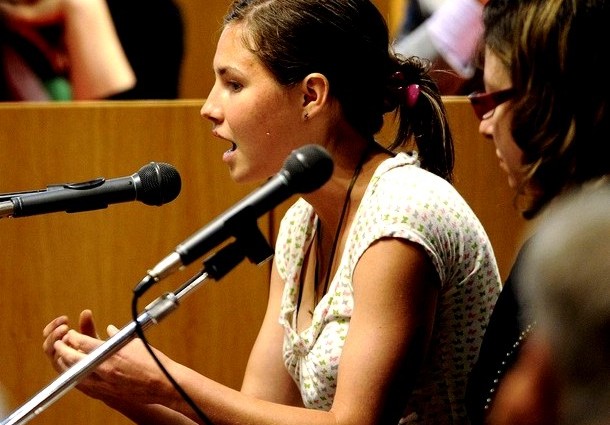
In our previous post Kermit nicely shows how, under the European Court of Human Rights’ own guidelines, Amanda Knox’s “appeal” won’t put her out of reach of the fair and painstaking Italians.
If any of the busy, hard-pressed ECHR investigators do choose to press beyond the ECHR guidelines, they will almost instantly establish that in her voluntary interview on 5 November 2007 Knox was treated with complete fairness.
Also that her false accusation of Patrick (which she never retracted) was entirely of her own doing.
And also that she is not only trying to throw sand into the wheels of Italian justice during an ongoing judicial process (a felony in Italy) but she is trying to welsh out of paying Patrick his damages award of $100,000 (a contempt of the Supreme Court) thus foolishly risking two more charges of aggravated calunnia.
This post derives from a post of mine last May. In another post, we showed that Dr Mignini was not present for the interrogation that night, and Knox maliciously invented an illegal interrogation at risk of a third aggravated calunnia charge.
In fact Dr Mignini met with Amanda Knox only briefly, later, to charge her and to warn she should say no more without a lawyer. He asked her no questions.
I will compare the various accounts of the interrogation to demonstrate that Amanda Knox is indeed lying to the ECHR, just as she did repeatedly in her book this year and also on US and European television.
- There are two main bodies of truth about the interrogation: (1) all of those present at various times on that night and (2) Knox’s own testimony on the witness stand in mid 2009.
- There are two main bodies of lies about the interrogation (1) The Sollecito book and (2) the Knox book, which by the way not only contradict one another but also contradict such other accounts as those of Saul Kassin and John Douglas.
The police had called her boyfriend Raffaele Sollecito in to the station for questioning and Knox had accompanied him because she did not want to be alone. They had already eaten at the house of a friend of Sollecito’s.
Knox’s interrogation was not tape recorded and in that sense we have no truly independent account of what transpired. The police, including the interpreter, gave evidence at her trial, but we do not yet have transcripts for that evidence other than that of the interpreter. There are accounts in books that have been written about the case but these tend to differ in the detail. The police and the interpreter maintain that she was treated well. Apart from the evidence of the interpreter all we have is what Knox says happened, and our sources for this are transcripts of her trial evidence and what she wrote in her book. I shall deal with the evidence of the interpreter towards the end of this article.
I am going to compare what she said at trial with what she wrote in her book but also there was a letter she wrote on the 9th and a recording of a meeting with her mother on the 10th November which are relevant.. What she wrote in her book is fairly extensive and contains much dialogue. She has a prodigious memory for detail now which was almost entirely lacking before. I am going to tell you to treat what she says in her book with extreme caution because she has already been found out for, well let us say, her creative writing if not outright distortion of facts. I shall paraphrase rather than quote most of it but a few direct quotes are necessary.
Knox arrived with Sollecito at the police station at about 10.30 pm (according to John Follain). The police started to question Sollecito at 10.40 pm (Follain).
In her book Knox describes being taken from the waiting area to a formal interview room in which she had already spent some time earlier. It is unclear when that formal questioning began. Probably getting on for about 11.30pm because she also refers to some questions being asked of her in the waiting room following which she did some stretches and splits. She then describes how she was questioned about the events over a period from about the time she and Sollecito left the cottage to about 9 pm on the 1st November.
Possibly there was a short break. She describes being exhausted and confused. The interpreter, Knox says, arrived at about 12.30 am. Until then she had been conversing with the police in Italian.
Almost immediately on the questioning resuming -
“Monica Napoleoni, who had been so abrupt with me about the poop and the mop at the villa, opened the door. “Raffaele says you left his apartment on Thursday night,” she said almost gleefully. “He says that you asked him to lie for you. He’s taken away your alibi.””
Knox describes how she was dumfounded and devastated by this news. She cannot believe that he would say that when they had been together all night. She feels all her reserves of energy draining away. Then -
“Where did you go? Who did you text?” Ficarra asked, sneering at me.
“I don’t remember texting anyone.”
They grabbed my cell phone up off the desk and scrolled quickly through its history.
“You need to stop lying. You texted Patrick. Who’s Patrick?”
“My boss at Le Chic.”
Stop right there.
How were the police able to name the recipient of the text? The text Patrick had sent her had already been deleted from Knox’s mobile phone by Knox herself and Knox hasn’t yet named Patrick. In fact she couldn’t remember texting anyone.
It is of course probable that the police already had a log of her calls and possibly had already traced and identified the owner of the receiving number for her text, though the last step would have been fast work.
In her trial testimony Knox did a lot of “the police suggested this and suggestd that” though it is never crystal clear whether she is accusing the police of having suggested his name. But she is doing it here in her book and of course the Knox groupies have always maintained that it was the police who suggested his name to her.
The following extract from her trial testimony should clear things up. GCM is Judge Giancarlo Massei.
GCM: In this message, was there the name of the person it was meant for?
AK: No, it was the message I wrote to my boss. The one that said “Va bene. Ci vediamo piu tardi. Buona serata.”
GCM: But it could have been a message to anyone. Could you see from the message to whom it was written?
AK: Actually, I don’t know if that information is in the telephone”¦”¦”¦”¦”¦”¦”¦..
GCM : But they didn’t literally say it was him!
AK : No. They didn’t say it was him, but they said “We know who it is, we know who it is. You were with him, you met him.”
GCM : Now what happened next? You, confronted with the message, gave the name of Patrick. What did you say?”
AK : Well, first I started to cry…....
And having implied that it was the police who suggested Patrick’s name to her, she adds”¦.. that quote again -
“You need to stop lying. You texted Patrick. Who’s Patrick?”
“My boss at Le Chic.”
Here she is telling the Perugian cops straight out exactly to whom the text was sent. “My boss at Le Chic”.
But that does not quite gel with her trial testimony -
And they told me that I knew, and that I didn’t want to tell. And that I didn’t want to tell because I didn’t remember or because I was a stupid liar. Then they kept on about this message, that they were literally shoving in my face saying “Look what a stupid liar you are, you don’t even remember this!”
At first, I didn’t even remember writing that message. But there was this interpreter next to me who kept saying “Maybe you don’t remember, maybe you don’t remember, but try,” and other people were saying “Try, try, try to remember that you met someone, and I was there hearing “Remember, remember, remember…..
Doesn’t the above quote make it clear that the police were having considerable trouble getting Knox to tell them to whom her text message was sent? It would also explain their growing frustration with her.
But perhaps the above quote relates not to whom the text was sent but, that having been ascertained, whether Knox met up with that person later? Knox has a habit of conflating the two issues. However there is also the following quote from her trial testimony -
Well there were lots of people who were asking me questions, but the person who had started talking with me was a policewoman with long hair, chestnut brown hair, but I don’t know her. Then in the circle of people who were around me, certain people asked me questions, for example there was a man holding my telephone, and who was literally shoving the telephone into my face, shouting “Look at this telephone! Who is this? Who did you want to meet?”
Then there were others, for instance this woman who was leading, was the same person who at one point was standing behind me, because they kept moving, they were really surrounding me and on top of me. I was on a chair, then the interpreter was also sitting on a chair, and everyone else was standing around me, so I didn’t see who gave me the first blow because it was someone behind me, but then I turned around and saw that woman and she gave me another blow to the head.
The woman with the long hair, chestnut brown hair, Knox identifies in her book as Ficarra. Ficarra is the policewoman who started the questioning particularly, as Knox has confirmed, about the texted message. “Look at this telephone! Who is this? Who did you want to meet?” Again, surely this is to get Knox to identify the recipient of the text, not about whether she met up with him?
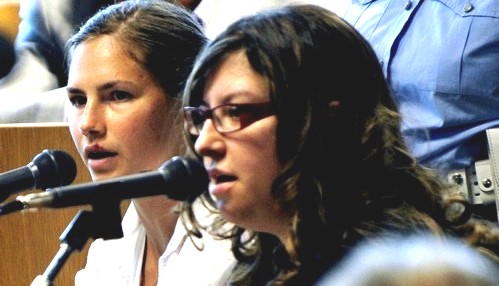
In the book though, it is all different.
In the book, the police having told her that the text is to someone called Patrick, Knox is a model of co-operation as, having already told them that he is her boss at Le Chic, she then gives a description of him and answers their questions as to whether he knew Meredith, whether he liked her etc. No reluctance to co-operate, no memory difficulties here.
Notwithstanding this, her book says the questions and insinuations keep raining down on her. The police insist that she had left Sollecito’s to meet up with - and again the police name him - Patrick.
“Who did you meet up with? Who are you protecting? Why are you lying? Who’s this person? Who’s Patrick?”
Remember again, according to her trial testimony the police did not mention Patrick’s name and Knox still hasn’t mentioned his name. But wait, she does in the next line -
“I said “Patrick is my boss.””
So now, at any rate, the police have a positive ID from Knox regarding the text message and something to work with. Patrick - boss - Le Chic.
Knox then refers to the differing interpretations as to what “See you later” meant and denies that she had ever met up with Patrick that evening. She recalls the interpreter suggesting that she was traumatized and suffering from amnesia.
The police continue to try to draw an admission from Knox that she had met up with Patrick that evening - which again she repeatedly denies. And why shouldn’t she? After all, she denies that she’s suffering from amnesia, or that there is a problem with her memory. The only problem is that Sollecito had said she had gone out but that does not mean she had met with Patrick.
Knox then writes, oddly, as it is completely out of sequence considering the above -
“They pushed my cell phone, with the message to Patrick, in my face and screamed,
“You’re lying. You sent a message to Patrick. Who’s Patrick?”
That’s when Ficarra slapped me on my head.”
A couple of blows (more like cuffs) to the head (denied by the police) is mentioned in her trial testimony but more likely, if this incident ever happened, it would have been earlier when she was struggling to remember the text and to whom it had been sent. Indeed that’s clear from the context of the above quotes.
And this, from her trial testimony -
Remember, remember, remember, and then there was this person behind me who—it’s not that she actually really physically hurt me, but she frightened me.”
In the CNN TV interview with Chris Cuomo, Knox was asked if there was anything she regretted.
Knox replied that she regretted the way this interrogation had gone, that she wished she had been aware of her rights and had stood up to the police questioning better.
Well actually, according to the account in her book, she appears to have stood up to the police questioning with a marked degree of resilience and self- certainty, and with no amnesia. There is little of her trademark “being confused”.
So why the sudden collapse? And it was a sudden collapse.
Given the trial and book accounts Knox would have us think that she was frightened, that it was due to exhaustion and the persistent and bullying tone of the questioning, mixed with threats that she would spend time in prison for failing to co-operate. She also states that -
(a) she was having a bad period and was not being allowed to attend to this, and
(b) the police told her that they had “hard evidence” that she was involved in the murder.
Knox has given us a number of accounts as to what was actually happening when this occurred.
In a letter she wrote on the 9th November she says that suddenly all the police officers left the room but one, who told her she was in serious trouble and that she should name the murderer. At this point Knox says that she asked to see the texted message again and then an image of Patrick came to mind. All she could think about was Patrick and so she named him (as the murderer).
During a recorded meeting with her mother in Capanne Prison on the 10th November she relates essentially the same story.
In her book there is sort of the same story but significantly without mention of the other officers having left the room nor mention of her having asked to see the texted message again.
If the first two accounts are correct then at least the sense of oppression from the room being crowded and questions being fired at her had lifted.
Then this is from her book -
In that instant, I snapped. I truly thought I remembered having met somebody. I didn’t understand what was happening to me. I didn’t understand that I was about to implicate the wrong person. I didn’t understand what was at stake. I didn’t think I was making it up. My mind put together incoherent images. The image that came to me was Patrick’s face. I gasped. I said his name. “Patrick””it’s Patrick.
It’s her account, of course, but this “Patrick - It’s Patrick” makes no sense at this stage of it unless it’s an admission not just that she had met up with Patrick but that he was at the cottage and involved in Meredith’s death.
And this is from her trial testimony -
GCM : Now what happened next? You, confronted with the message, gave the name of Patrick. What did you say?
AK : Well, first I started to cry. And all the policemen, together, started saying to me, you have to tell us why, what happened? They wanted all these details that I couldn’t tell them, because in the end, what happened was this: when I said the name of Patrick I suddenly started imagining a kind of scene, but always using this idea: images that didn’t agree, that maybe could give some kind of explanation of the situation.
There is a clear difference between these two quotes.
The one from her book suggests that she was trying hard but that the police had virtually brought her to the verge of a mental breakdown.
Her trial testimony says something else; that a scene and an idea was forming in her mind brought on by her naming of Patrick.
In her book she states that a statement, typed up in Italian, was shoved under her nose and she was told to sign it. The statement was timed at 1.45 am. The statement was not long but would probably have taken about twenty minutes to prepare and type.
The statement according to Knox -
... I met Patrick immediately at the basketball court in Piazza Grimana and we went to the house together. I do not remember if Meredith was there or came shortly afterward. I have a hard time remembering those moments but Patrick had sex with Meredith, with whom he was infatuated, but I cannot remember clearly whether he threatened Meredith first. I remember confusedly that he killed her.
The fact that the statement was in Italian is not important. Knox could read Italian perfectly well. However she does insinuate in the book that the details in the statement were suggested to her and that she didn’t bother to read the statement before signing.
Apart from what has been mentioned above, there are some other points and inferences to be drawn from the above analysis.
- 1. Knox’s account destroys one of Sollecito’s main tenets in his book Honour Bound. Sollecito maintains that he did nothing to damage Knox’s alibi until he signed a statement, forced on him at 3:30 am and containing the damaging admission that Knox had gone out. But Knox makes it clear that she had heard from the Head of the Murder Squad that he had made that damaging admission, at or shortly after 12.30 am. Or is Knox is accusing Napoleoni of a bare-faced lie?
2. It is valid to ask why Knox would not want to remember to whom the text had been sent. Who can see into her mind? Perhaps Knox realized that discussion of it would confirm that if she had indeed gone out then it was not to Le Chic, where she was not required. However even if she thought that could put her in the frame it’s not what an innocent person would be too worried about. Perhaps she did just have difficulty remembering?
3. If there was no fuss and she did remember and tell the police that the text was to Patrick, and the questioning then moved on to whether she met up with Patrick later that evening, what was the problem with that? She knew the fact that she hadn’t met up with him could be verified by Patrick. She could have said that and stuck to it. The next move for the police would have been to question Patrick. They would not have had grounds to arrest him.
4. Knox stated in her memorial, and re-iterates it in her book, that during her interrogation the police told her that they had hard evidence that she was involved in Meredith’s murder. She does not expand on what this evidence is, perhaps because the police did not actually tell her. However, wasn’t she the least bit curious, particularly if she was innocent? What was she thinking it might be?
5. I can sympathise with any interviewee suffering a bad period, if that’s true. However the really testy period of the interview/interrogation starts with the arrival of the interpreter, notification of Sollecito’s withdrawal of her alibi and the questioning with regard to the text to Patrick, all occurring at around 12.30 am. There has to be some critical point when she concedes, whether to the police or in her own mind, that she’d met “Patrick”, after which there was the questioning as to what had happened next. Say that additional questioning took 20 minutes. Then there would be a break whilst the statement is prepared and typed up. So the difficult period for Knox, from about 12.30 am to that critical point, looks more like about 35 to, at the outside, 50 minutes.
6. Even if, for that period, it is true that she was subjected to repeated and bullying questions, and threats, then she held up remarkably well as I have noted from her own account. It does not explain any form of mental breakdown, let alone implicating Patrick in murder. In particular, if Knox’s letter of the 9th and the recording of her meeting with her mother on the 10th are to believed, that alleged barrage of questions had stopped when she implicated Patrick. An explanation, for what it’s worth, might be that she had simply ceased to care any longer despite the consequences. But why?
7. A better and more credible explanation is that an idea had indeed formed suddenly in her mind. She would use the revelation about the text to Patrick and the consequent police line of questioning to bring the questioning to an end and divert suspicion from her true involvement in the murder of Meredith Kercher. She envisaged that she would be seen by the police as a helpless witness/victim, not a suspect in a murder investigation. As indeed was the case initially. She expected, I am sure, to be released, so that she could get Sollecito’s story straight once again. If that had happened there would of course remain the problem of her having involved Patrick, but I dare say she thought that she could simply smooth that over - that it would not be a big deal once he had confirmed that there had been no meeting and that he had not been at the cottage, as the evidence was bound to confirm.
At the beginning I said that we also have a transcript now of the evidence of the interpreter, Anna Donnino. I will summarise the main points from her evidence but it will be apparent immediately that she contradicts much of what Knox and her supporters claim to have happened.
Donnino told the court that she had 22 years experience working as a translator for the police in Perugia. She was at home when she received a call from the police that her services were required and she arrived at the police station at just before 12.30 am, just as Knox said. She found Knox with Inspector Ficarra. There was also another police officer there whose first name was Ivano. At some stage Ficarra left the room and then returned and there was also another officer by the name of Zugarina who came in. Donnino remained with Knox at all times
The following points emerge from her testimony :-
- 1. Three police officers do not amount to the “lots of people” referred to in Knox’s trial testimony, let alone the dozens and the “tag teams” of which her supporters speak.
2. She makes no mention of Napoleoni and denied that anyone had entered the room to state that Sollecito had broken Knox’s alibi. (This is not to exclude that this may have happened before Donnino arrived)
3. She states that Knox was perfectly calm but there came a point when Knox was being asked how come she had not gone to work that she was shown her own text message (to Patrick). Knox had an emotional shock, put her hands to her ears and started rolling her head and saying “It’s him! It’s him! It’s him!”
4. She denied that Knox had been maltreated or that she had been hit at all or called a liar.
5. She stated that the officer called Ivano had been particularly comforting to Knox, holding her hand occasionally.
6. She stated that prior to the 1.45 am statement being presented to Knox she was asked if she wanted a lawyer but Knox said no.
7. She stated that she had read the statement over to Knox in english and Knox herself had checked the italian original having asked for clarification of specific wording.
7. She confirmed that that she had told Knox about an accident which she’d had (a leg fracture) and that she had suffered amnesia about the accident itself. She had thought Knox was suffering something similar. She had also spoken to Knox about her own daughters because she thought it was necessary to establish a rapport and trust between the two of them.
The account in Knox’s book is in some ways quite compelling but only if it is not compared against her trial testimony, let alone the Interpreter’s testimony: that is, up to the point when she implicates Patrick in murder. At that point no amount of whitewash works. The Italian Supreme Court also thought so, upholding Knox’s calunnia conviction, with the addition of aggravating circumstances.
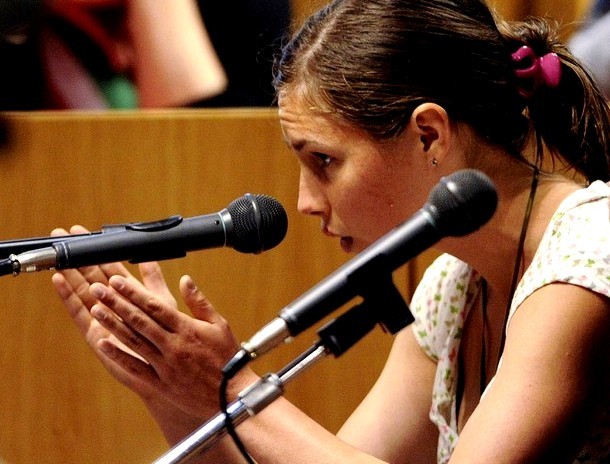
Wednesday, November 27, 2013
Amanda Knox Lies Again To Get Herself Into Another European Court “But Really, Judge, Its Only PR”
Posted by Kermit
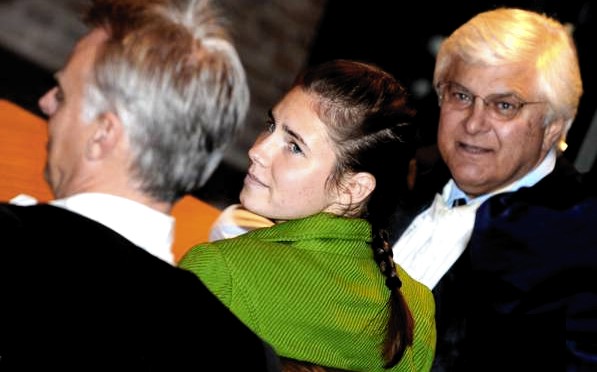
[Amanda Knox’s lawyer Luciano Ghirga (right): “Amanda wasn’t hit, we made no complaint”]
Introduction
This is the first of two posts on Knox’s claim to have sent an appeal to the Strasbourg-based European Court of Human Rights (ECHR).
Last Monday the main event that followers of the Meredith Kercher murder case were awaiting was the closing argument by Prosecutor Alessandro Crini in Amanda Knox’s and Raffaele Sollecito’s appeal trial.
Dr Crini’s structuring of the prosecution’s case in 16 points demolished the defendants’ efforts to present the volume of evidence against them as an incredible, long series of mistakes, coincidences and misunderstandings.
It seems, however, that Amanda Knox and her people didn’t want the public to be too fascinated by Dr Crini’s devastating argument. They really wanted them to be distracted by what can only be seen as an ill-judged public relations move, breaking yet more laws along the way.
Knox attempted to blow smoke over the prosecution’s arguments by grandly announcing “today, my lawyers filed an appeal of my slander[sic] conviction with the European Court of Human Rights.” That explanation of her PR ploy calls for a close review of her eligibility (here) and her so-called proof (next post).
Knox’s eligibility or otherwise
The European Court of Human Rights, is a supranational European tribunal dedicated to ““ as its name suggests - human rights.
It is not dedicated to criminal or civil proceedings on murder, sexual assault, theft, simulation of a crime, or any of the other charges that Knox faces.
In fact, to avoid the many unnecessary or spurious applications which hamper real cases getting attended to, the ECHR provides a number of online resources on who may apply and how and why.
One of the first issues that its advice underlines is that it is not a glorified appeals court:
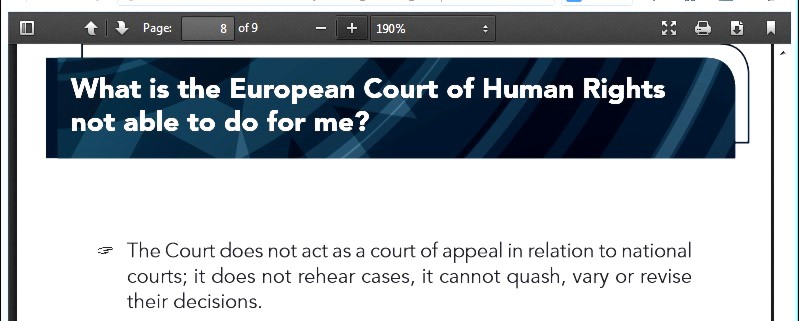
It is strange then, that Amanda Knox claims that her lawyers have “appealed” her case to the ECHR.
Either Knox’s legal advisors are just ignorant (which ones? The Italian professionals, or the American media hacks?) or this is simply a last-ditch Hail Mary action as an extradition request moves inexorably closer.
If the ECHR makes clear that it isn’t a court of appeal, there shouldn’t be any direct correlation between the Supreme Court confirming her as a convicted criminal and her application to the ECHR.
If that is in fact the basis of their application, it will not go far before rejection. In fact, the vast majority (more than 95%) of applications get rejected:
“For a number of years now, and owing to a variety of factors, the Court has been submerged by individual applications (over 130,000 were pending as at 31 August 2010). The overwhelming majority of these applications (more than 95%) are, however, rejected without being examined on the merits for failure to satisfy one of the admissibility criteria laid down by the Convention.
This situation is frustrating on two counts.
Firstly, as the Court is required to respond to each application, it is prevented from dealing within reasonable time-limits with those cases which warrant examination on the merits, without the public deriving any real benefit.
Secondly, tens of thousands of applicants inevitably have their claims rejected, often after years of waiting.”
It would be a outrageous if other, real human rights cases were delayed due to a Public Relations ruse as part of an extra-judicial strategy to undermine a request for Knox’s extradition.
Other ECHR on-line resources help potential applicants decide if they be eligible to be heard at the Court.
Below, a work-flow chart presents the main steps, including various “Admissibility Criteria”:
A first admissibility criterion
The first Admissibility criterion is that an applicant has exhausted “domestic remedies” in pursuing the recognition and correction of the human rights he or she feels have been abused.
Knox in her application to the ECHR directly relates the Italian Supreme Court final confirmation of her “calunnia” sentence (three years for obstruction of justice for framing her kindly boss Patrick Lumumba as the murderer of Meredith Kercher, thereby throwing off the course of the investigation) to her application to the ECHR.
But what were the supposed human rights abuses suffered? What did she do to remedy them?
The first requirement of exhausting “domestic remedies” means that the rights abuses that Knox alleges she has suffered have been pursued in Italy, and that all possible instances of reclamation in Italy have been visited.
However, as far as the public knows, Knox has not even placed a formal complaint concerning supposed civil rights abuse. Certainly her own Italian lawyers have said they havent.
The US and Italian publics would be interested in seeing her specific claims to the ECHR and whether there is any registration of such claims or complaints with the Italian police or other administrative or NGO offices.
Knox’s needling stepfather, Chris Mellas, stated in April 2008 on a precursor to the PMF discussion forum that a complaint had been filed concerning Amanda being hit during questioning.
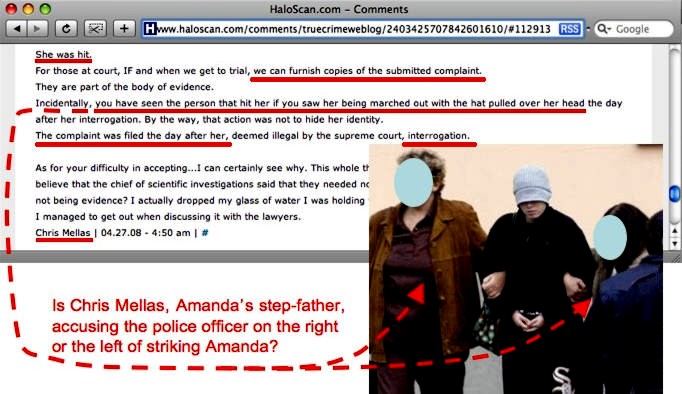
[Click for larger version]
However, nothing more has ever been heard of this complaint, which definitely would have been a starting point for pursuing domestic Italian remedies to the claimed rights abuse.
Since it appears zero rights abuses have been pursued in Italy, and the date of Knox’s application to the ECHR is in effect unrelated to her “calunnia” sentence confirmed by the Supreme Court, the six month limit beyond national remedies related to the rights abuse for applying to the ECHR is irrelevant here.
It should be noted that when Prosecutor Crini asked this week for an addition to Knox’s confirmed sentence for “calunnia”, adding another year to the three years already served by the convicted criminal, this is not a reopening of the “calunnia” case or an example of “double jeopardy”, but rather the reassessment on appeal of a separate, pending issue related to the basic calunnia charge: whether it should include an additional year of sentence for being aggravated.
Since this aggravation addition to the charge is awaiting determination, and follows from instructions of the Italian Supreme Court (and could result in an additional year in prison), it is not part of the prior, confirmed sentence.
A second admissibility criterion
Now just in case Knox or her lawyers would like to allege any perceived human rights abuse whatsoever in their ECHR application, the Strasbourg court insists on the reclamation in question being directly related to one of the sections of the European Convention on Human Rights
I’ve gone through it and I see chapters related to illegal detention (detention permitted only following arrest) and torture, but nothing related to getting cuffed on the back of your head.
If such an event ever occurred, it shouldn’t have, but quite likely one of the other authorities or rights bodies listed by the ECHR may be better equipped to deal with it.
This is a second Admissibility Criterion that filters out many applications: one can’t simply run to the ECHR saying “my rights have been abused” ““ the issue at hand must be directly related to the European Convention on Human Rights.
I seriously doubt the “hitting” event ever occurred because Knox’s own Italian lawyer Luciano Ghirga denied it, stating to the Press on 21 October 2008:
Amanda wasn’t hit. There were pressures fom the police, sure, but we never said she was hit.
As our next post here on this same subject will show, even Knox herself admitted she was treated well.
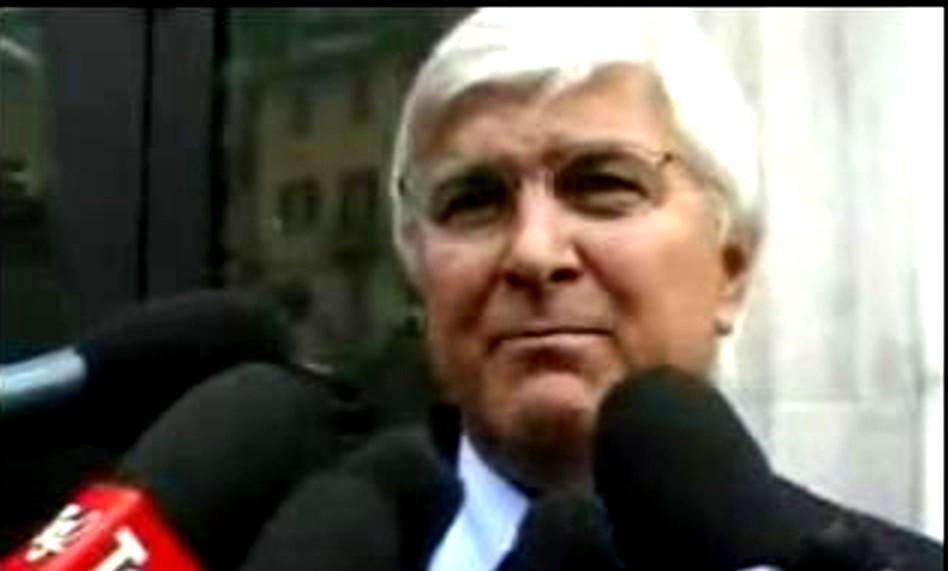
[Above: Amanda Knox’s Italian courtroom lawyer stating to the Press in 2008 that she had not been hit.]
If Knox hasn’t even tried to remedy being allegedly hit in Italy by suing or making formal complaints, nevertheless the Italian police certainly have acted upon such suggestions.
A number of legal processes are under way against Knox and her family members for slander and calunnia. Knox might face two more charges of aggravated calunnia. Why do I doubt that Knox has even mentioned those other legal processes in her application to the ECHR?
Those charges would of course have to be taken care of (as part of “exhausting domestic remedies”) before the ECHR would be able to consider her application, assuming it surmounted all of its other shortcomings to get to the ECHR judges’ hands.
A third admissibility criterion
Another Admissibility Criteria is the “Significant Disadvantage” filter. If an alleged rights abuse is minimal ““ compared to the very serious issues that the ECHR was created to consider ““ the application will go no further.
The only violent description of Knox’s alleged beating was given by her stepfather, Chris Mellas: “She was interrogated, and hit, and threatened,” he typed. “Tortured. Physically and mentally”.
However, there was never any medical or forensic notification of such “torture” before or after her incarceration in Capanne Prison.
Rather, Knox spent her time in prison receiving regular visits from a lovelorn Italian politician who befriended her, and participating in prison musical and theatrical activities.
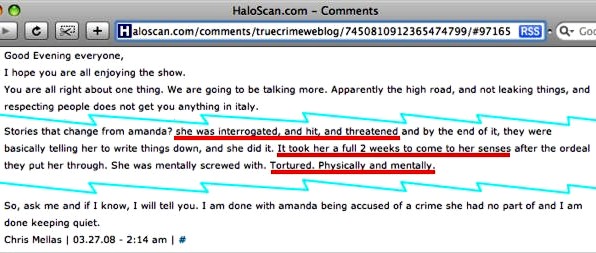
[Click for larger version]
In underlying the “significant disadvantage” requirement, the ECHR states in its examples of rejected claims, that it can’t be distracted by the French driver who lost a point on his driver’s licence, or the Romanian who claims 90 euros from the State, when the Court has real and serious Human Rights cases to deal with such as:
- El-Masri v. the former Yugoslav Republic of Macedonia (Article 3 of European Convention on Human Rights: Torture and inhuman and degrading treatment during and following applicant’s extraordinary rendition to CIA)
- Hirsii Jamaa and others v. Italy (Article 4 of Protocol No. 4: Return of migrants intercepted on the high seas to country of departure)
It’s almost certain that Knox has not pursued on an Italian level any remedies to her alleged human rights abuse (whatever it was), nor is there any evidence that the investigation into Meredith Kercher’s murder and the subsequent trials of Knox, Rudy Guede and Raffaele Sollecito were affected in their outcome by the rights abuse.
This is especially the case if the limit of Knox’s human rights suffering is that described by a talky ex-FBI helicopter pilot turned ex-college security guy turned Amanda Knox groupie, Steve Moore.
Moore describes the “frightful” circumstances of Knox’s witness questioning on the night of 5 November 2007 for the couple of hours (perhaps even somewhat less) that it lasted:
No food, no coffee, no bathroom breaks ““ nothing.
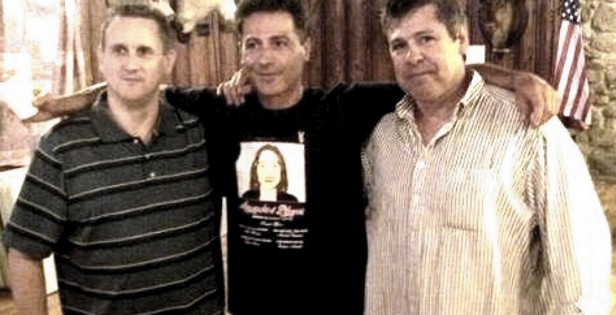
Above is ex-college security man Steve Moore, right, together with PR flunkie Bruce Fischer, left, both flanking “Frank Sfarzo”, a Knox-Mellas family friend.
Francesco Sforza is currently a fugitive from the Seattle courts on two counts of Assault-Domestic Violence, who continues to support Amanda in ongoing Internet blog posts, from wherever he may be.
See below. Click for larger. In purple, my corrections to Knox’s “what-I-want-the-World-to-believe” post about applying to the ECHR.
In conclusion
Between the manifest doubtfulness of the acceptability of Knox’s application to the European Court of Human Rights, on one hand, and the falsehoods and half-truths in her announcement, on the other, why do I get the feeling that the only reason and hope she and her team have in announcing the application (whether really filed or not) is to distract the attention of the followers of her appeal trial from the prosecution’s weighty arguments?
This will have little if any effect on the wheels of Italian Justice, and probably even less on a State Department more concerned with maintaining good relations with European allies while diplomatic challenges occur in the Middle East and Asia, than with a lobby plan to prevent Knox’s extradition.
[Below: The European Court of Human Rights in Strasbourg France]
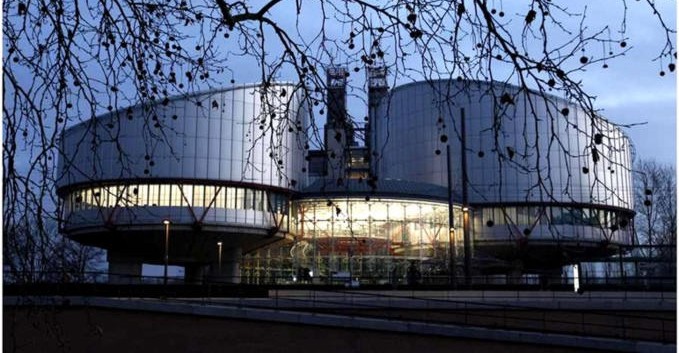
Tuesday, November 26, 2013
Appeal Session #5: Prosecutor Alessandro Crini Concludes, Proposes 30 Years For AK And 26 For RS
Posted by Our Main Posters
Overview
This is the report on the second day of Prosecutor Crnini summarizing the entire case.
This was not attempted at such length at the 2011 Hellman appeal and that panel of judges was perhaps not ever fully in the picture. The first day of the presentation is reported on here.
Real-Time Reporting, Bottom Up
4. Assessment by main poster SeekingUnderstanding
The case put forward by the prosecution and reported to us by Yummi is almost startling in its lucid and concise approach.
It couldn’t be more in contrast to the equivocations and disingenuousness, as well as irrelevant sentimentality that we have unfortunately become used to witnessing. The cutting use of logic was therefore refreshing, and gives grounds for optimism, albeit it tempered by unknowns.
All the issues seemed to be addressed from the base line, as if from primary considerations. And many points were simply politely dismissed as being unimportant to the true case in hand -which is the establishment of the guilt (or not) of the accused. For example, it was great to hear that the reason why the knife had been brought to the cottage need not be examined - it was enough that it was there.
It seemed that where the defence had challenged the evidence, for example suggesting contamination of DNA, it was here that Crini spared no detail, and took time in bottoming out the logic, and dispensing with their points. His arguments certainly carried conviction to me.
I was glad to see motive and behavioural dynamics looked at, as indeed Cassation had requested. It seemed good too that Crini ruled out premeditation, and reduced the dynamics to something highly plausible and believable as well as simple. There are just two points I might observe :
First, it would seem within character for Meredith to have been both open and direct in confronting issues of hygiene, drug use, infringement of privacy and noise etc., (or even theft of rent money, another possibility). I am not convinced that she would necessarily have been aggressively confrontational. Someone who is relaxed within themselves, accepting of their self, is well able to be assertive in a non-provocative manner. That is quite British too - especially old-fashioned English.
Secondly, bearing in mind the possible or probable profiles of the defendants, it would not have taken more than one small trigger of reasonable confrontation to release the consequent temper-tantrum or drug fuelled rage. I do not think we are dealing with something proportionate - and this is also why it escalated in the terrifying way it did. I don’t think it is essential to hypothesize as to what in particular Meredith raised an objection to (e.g. Rudy’s bathroom event). It is probable that Meredith’s concerns were reasonable, and then the overly defensive and angry reaction to any criticism whatsoever was unreasonable. I personally think this is enough.
I liked the way Crini said that even though a source is unreliable or not credible in some ways, that does not mean they do not (inadvertently as it were) give out information that is also true and useful. Possibly other statements from Guede might be taken into account in this way?
As a psychologist, it would seem dialogue with Rudy might yet be fruitful, but, with things the way they remain with the other two, it does not seem the time now for further words. Something else needs to happen.
3. Assessment by main poster James Raper
Crini spent about 10 hours in total addressing the court and was certainly very thorough. Maresca was so impressed that there was no need for him to add anything further.
Crini came to the prosecution case without the baggage of having presented any previous scenario or of having had his reputation sullied and slandered by the Knox PR machine. He reviewed the evidence dispassionately and found it compelling.
Clearly he also found the previous machinations of C&V and the Hellmann court objectionable and went in hard here, even discussing previous cases where Vecchiotti and Conti had goofed up. Hellmann had tried so hard to avoid that coming out during his appeal.
He was not, however, averse to taking a different tack where he thought this was appropriate. A sign of his intellectual honesty which may have impressed the court.
For instance, he thought that there was no need to nail TOD down to 11.30pm as Mignini had sought to do. He allowed for an earlier TOD.
He was of the opinion that coming up with an exact time line for a period in which there is no alibi, and when there is already evidence of involvement in murder, is of only marginal interest.
He spent well over an hour discussing the knife. He did not think it necessary to mull over how it came to be at the cottage. That is speculation that need not detain anyone if the knife is accepted as the murder weapon, and he thinks that on all the evidence it is.
He ruled out premeditation, even as to a hazing, and presented a very simple scenario as to motive and the dynamics behind and during the attack on poor Meredith. Keeping it simple makes it understandable to everyone. Elaborate further and you risk alienating someone who disagrees with the elaboration and thinks they have a better theory.
My only objection is that it is a tad ridiculous to believe that Meredith objected to poop being left in the toilet, the toilet she didn’t use. But yes, the objectionable behaviour of a trio of drunken/drugged up louts invading her space would most likely have triggered argument, unpleasantness and then a fight.
There is plenty of character evidence to support that scenario and with a little imagination, and some recollection of one’s student days, one can easily see how this might have gone. In a way, and Crini admitted to this possibility, Meredith’s own behaviour, or misreading of the situation, may also have been a trigger. Whether one agrees with this or not, it is at least a believable and honest suggestion.
So he set out base camp for the court (bearing in mind that Cassation had suggested that behavioural dynamics be given serious consideration by the appeals court) and whether the judges elaborate further (perhaps by conjecturing a possible range of equally valid motives and dynamics) is up to them.
2. Assessment by main poster Hopeful
Crini is magnificent! He’s absolutely crushing the defense. He nails Knox as having left her bloody shoeprint on the pillow under Meredith.
He accepts Novelli who found Meredith’s trace on the knife. He believes Knox left DNA on the knife. He quotes from differing experts Gill and Balding and says Sollecito’s DNA on the bra clasp stands.
He describes a small, very sharp knife that he believes was used to cut off the bra in several places. He says the knifeprint on the sheet was from the big kitchen knife.
Crini contends that the strong bruise marks around Meredith’s mouth were from restraining her and blocking the scream.
He believes this fight was caused by Meredith angrily reacting to Knox’s constant dirty ways in the cottage and Guede’s nasty toilet habit along with his and Sollecito’s unwanted presence in the cottage that night.
Crini argues a crime of rage when Knox was confronted by Meredith, citing Laura Mezetti’s remarks about the cleaning conflicts. Crini says that Meredith’s scream is what caused the fatal knife blow to silence her.
Not premeditated, the murder was the final result of the perps’ terror that they had gone too far during the raging fight. He’s asking for 30 years for Knox and asks to increase sentence for calunnia to 4 years, inclusive in the 30.
He almost laughs at Knox’s weak excuse over the drops of her blood found in the bathroom, saying she would surely have known if she bled.
He confirms the storekeeper did see Knox early in the morning after the crime. He finds no proof of Sollecito being firmly at his computer sending emails during the crime. He blasts the Knox and Sollecito alibis as being a tissue of lies.
Crini has another ex-Supreme Court justice standing with him in the Florence courtroom! (Baglione). Crini has worked extremely hard. He has conquered this convoluted pack of lies and distortions and his diligence shows. He upturned the applecart of Conti-Vecchioti nonsense and thoroughly redeemed Stefanoni’s findings.
He has completely severed the heads of this Medusa Gorgon mess, Crini is the bomb!
1. Tweets continue from main poster Yummi
114. This means a total request of 30 years for Knox and 26 years for Sollecito
113. [Propose] 26 years for both for the murder
112. The murder is contextual, their was no premeditation, and no futile motive
111. Because of their staging and denials, they should not be given generic mitigation for murder.
110. Requests to increase the penalty for [Knox] calunnia to 4 years
109. But experience tells statements of unreliable perps do contain revelations about the truth. The ‘argument’ between girls, why such context?
108. Rudy Guede has no credibility, even if the Supreme Court is right that this cannot depend on his refusal to answer.
107. Crini cites Laura Mezzetti about the ‘annoyance’ caused by Knox on house cleaning issues.
106. Meredith was the one triggering an argument because of the ‘impolite’ invasion and behavior. She accused Knox .
105. Rudy was not sober, quite high, a bit annoying, and was acting the same disgusting way he behaved downstairs days before.
104. Meredith Kercher was sober, fully awake. The others were at least ‘smoked’, a bit high, Rudy was there in the house.
103. The motive is not futile, the motive is terror, it is the consequence of the prior aggressive action in which they were involved.
102. Nothing points to an agreed plan among the three that run out of control; the first cause was an aggression, a clash, impetus of rage
101. Crini: there is a prosecution duty to conjecture a motive.
100. The blood drop on the tap: a point is Knox does not explain, guesses, while she must be aware that she bled in the bathroom.
99. Crini believes the shoe prints on the pillowcase are from a female’s shoe as suggested by police
98. Knox’s DNA between the blade and the handle (36-i)is very significant. It’s not from sweat or contact.
97. The print on the bed sheet is compatible with the kitchen knife.
96. Crini: we don’t need to figure a reason for a kitchen knife to be carried from one apartment to the other..
95. The bra straps are cut in multiple points, not with a kitchen knife.
94. Sollecito cut her bra with a knife in multiple parts. hold bra to cut it - no Guede’s DNA in that point - used a small very sharp-edge knife
93. Rudy did not stab her, because he wad used both his hands, which were unarmed
92. Wounds indicate she was immobilized by multiple people, they killed her because failing to do so completely, were terrified by her scream.
91. Criticizes Torre’s theory that the large wound could be caused by a small knife: improbable, the wound has clear margins.
90. There were two knifes, one was small, not much fit to kill.
89. Ridiculous to think that Rudy Guede - which she knew - could intimidate Meredith totally to that point. She would react.
88. Specific indicator: no defence wounds; means bruises are not from fight but restraint.
87. Description of bruises and lesions around her mouth, indicates extreme force to prevent from screaming. Rest of body was also immobilized.
86. She was still wearing a blue sweater which was removed subsequently.
85. Analysis of blood drop pattern and position of victim when stabbed; body moved in a different position.
84. Location of crime - space between the bed and the wardrobe - is peculiar, analysed by UACV
83. Crini says will sketch a dynamic of events of the crime.
82. Crini says - implying Vecchiotti, Pascali - some experts should be “hold where they belong”
81. Crini recall Pascali working on the Olgiata and the Claps case (2008, 2010);
80. There is no instance of transfer of Sollecito’s DNA anywhere on the scene
79. Crini cites the Olgiata case.
78. Contamination must be deduced from context of finding and collection. You must think a practical way for Sollecito’s DNA to be transferred
77. Tagliabracci defends Vecchiotti saying the RIS statistical techniques were not used at the time; Crini cites Gill and Balding
76. Guede’s Y haplotype in victim’s vagina alone was used to identify him.
75. Sollecito’s DNA is certainly on the clasp for the police; Vecchiotti doubts but considers X separately from Y haplotype
74. The bra clasp: the first objection was the interpretation of the mixed/complex trace
73. Crini says he learned a bit of genetics working on cold cases
72. Vecchiotti and Tagliabracci have a reliability problem in relation to the case, for different reasons
71. Vecchiotti said she obtained all cooperation she required. Raw data could be accessed by accessing the machine itself as Stefanoni offered.
70. Crini says he found out the negative controls were deposited, the court will find the document of deposit etc.
69. Vecchiotti omitted to note the censures/observations written by the other consultants, this procedure is incorrect
68. Vecchiotti’s approach to the I-trace (refusal to test it ) was ‘ideological’, ‘weak’, ‘insufficient’
67. Interpretation of profile is for complex result. For non-complex profiles there is actually no ‘interpretation’.
66. Crini recalls answers by the RIS, defence tried to elicit approval of CV, but RIS said multiple test only if possible, compromise for result
65. Novelli cited saying the profile of Meredith is certain.
64. Meredith’s profile came out clean on a single amplification, means the trace is clear.
63. The meaning of test repetition is its necessity when you have a ‘dirty’, uncertain sequence like Knox’s profile on the knife
62. Novelli knows very well about double and triple amplification protocols, and Stefanoni knows well too
61. Guidelines are an indication that guide your driver, but then you have to drive
60. Someone who keeps a refrigerator like the one Vecchiotti has, should be less critical about laboratory practice
59. Crini: should we toss any result in the garbage, no matter how important and clear, whenever the test is not repeated?
58. Speaks about the single amplification by Stefanoni versus guidelines.
57. The presence of human DNA in a scratch on the blade of a knife itself is not usual
56. Crini: another introduction specific on DNA; notes btw that the new RIS finding is ‘important’ because adds information
55. Crini makes an introduction about circumstantial evidence
54. Discussion on DNA and remaining evidence will start in 1h.
53. Francesco Sollecito [in interview] was shocked, said he never expected so aggressive arguments from PG [the Tuscany Prosecutor General]
52. Yesterday, Crini spent the first hour to argue about logical ‘method’: how assess evidence altogether, examples, quotes of SC sentences

